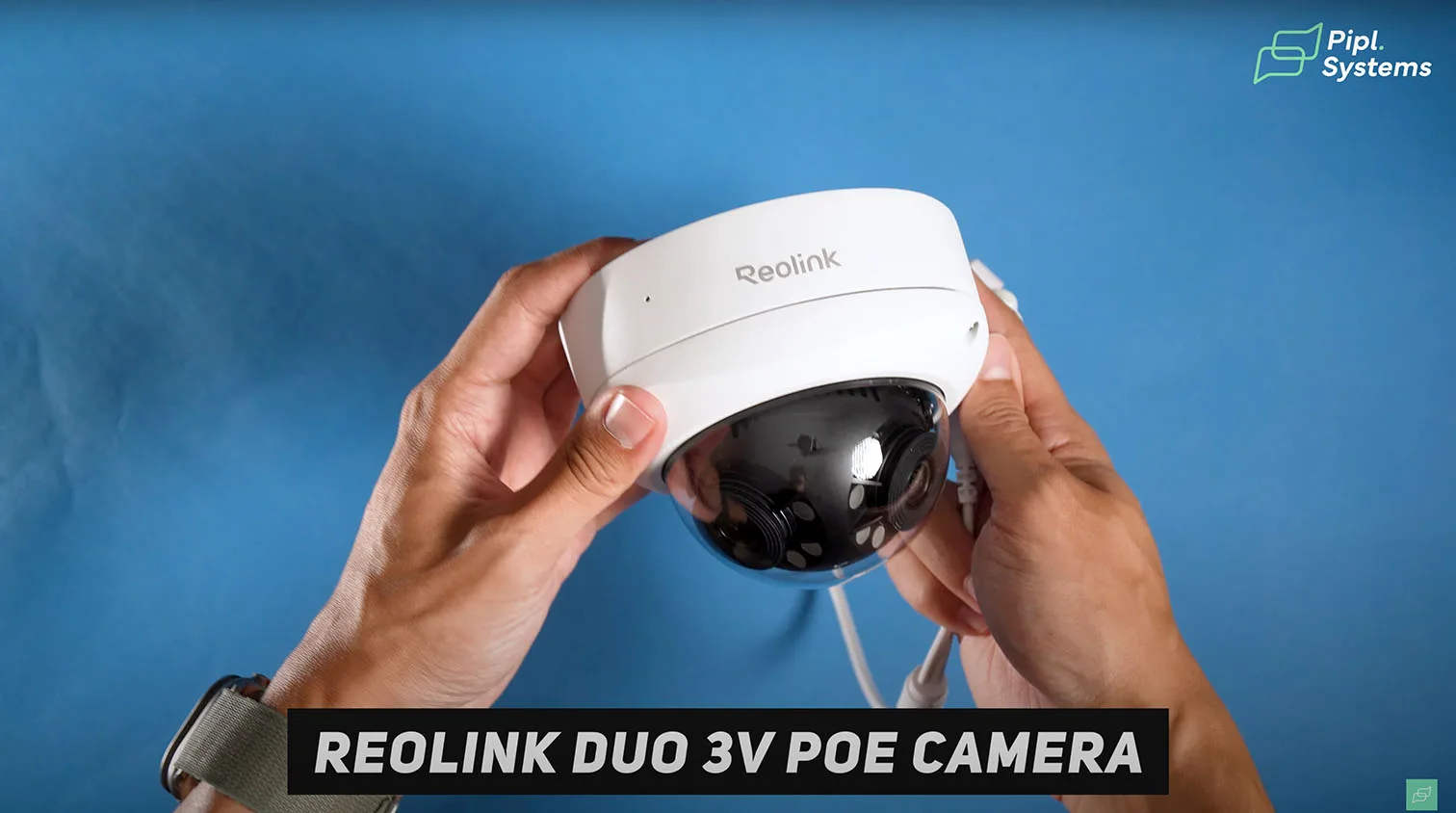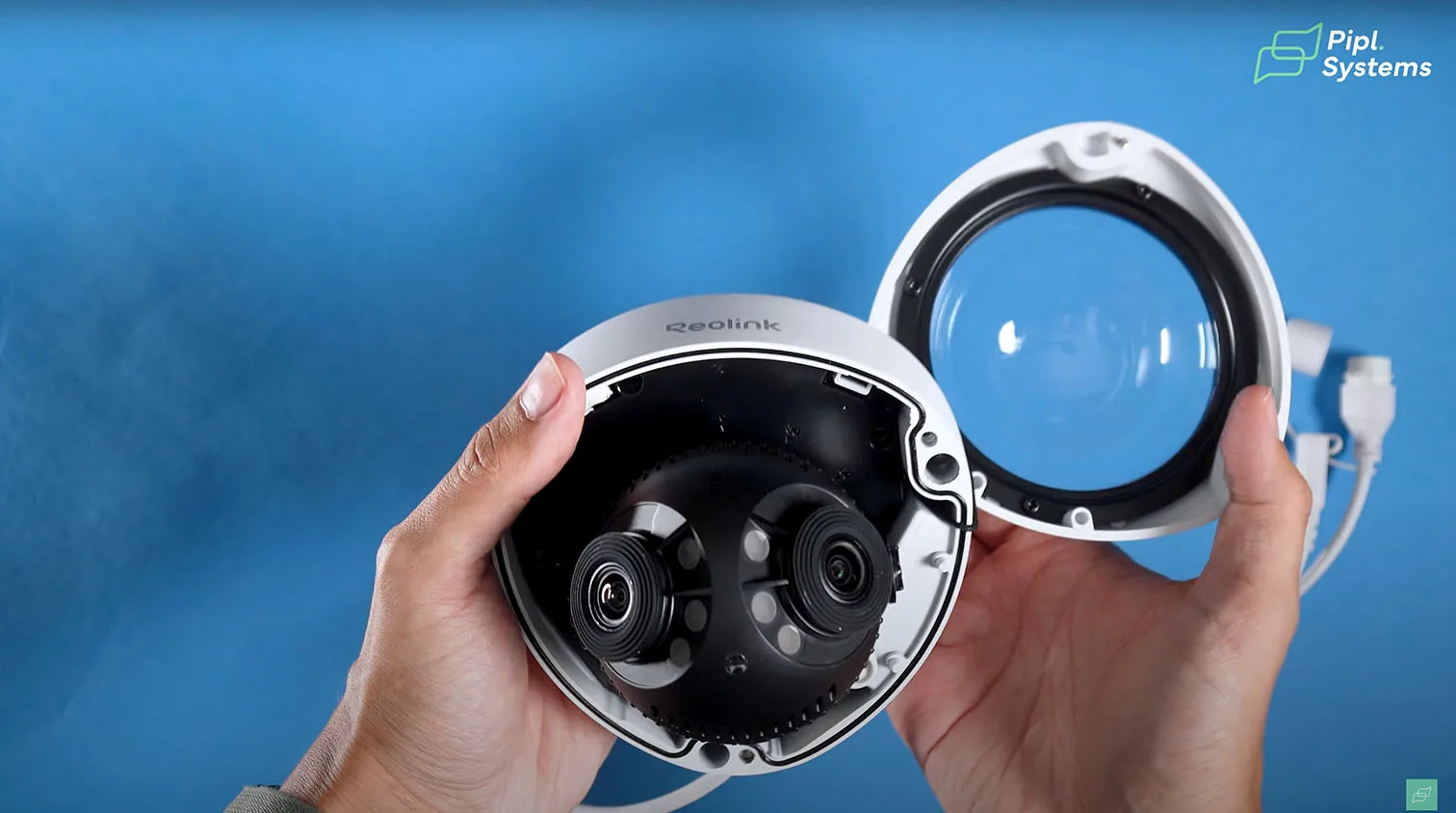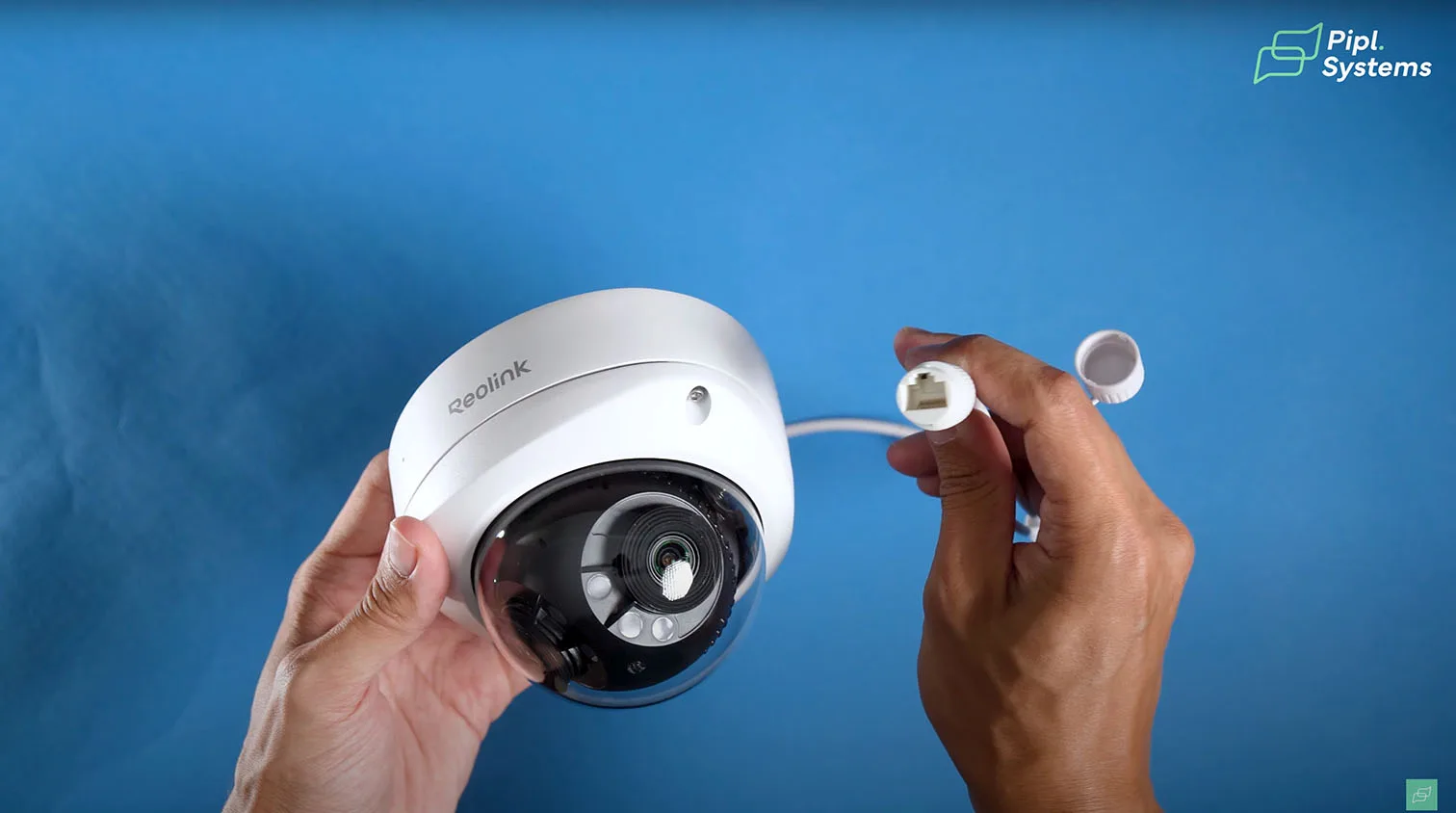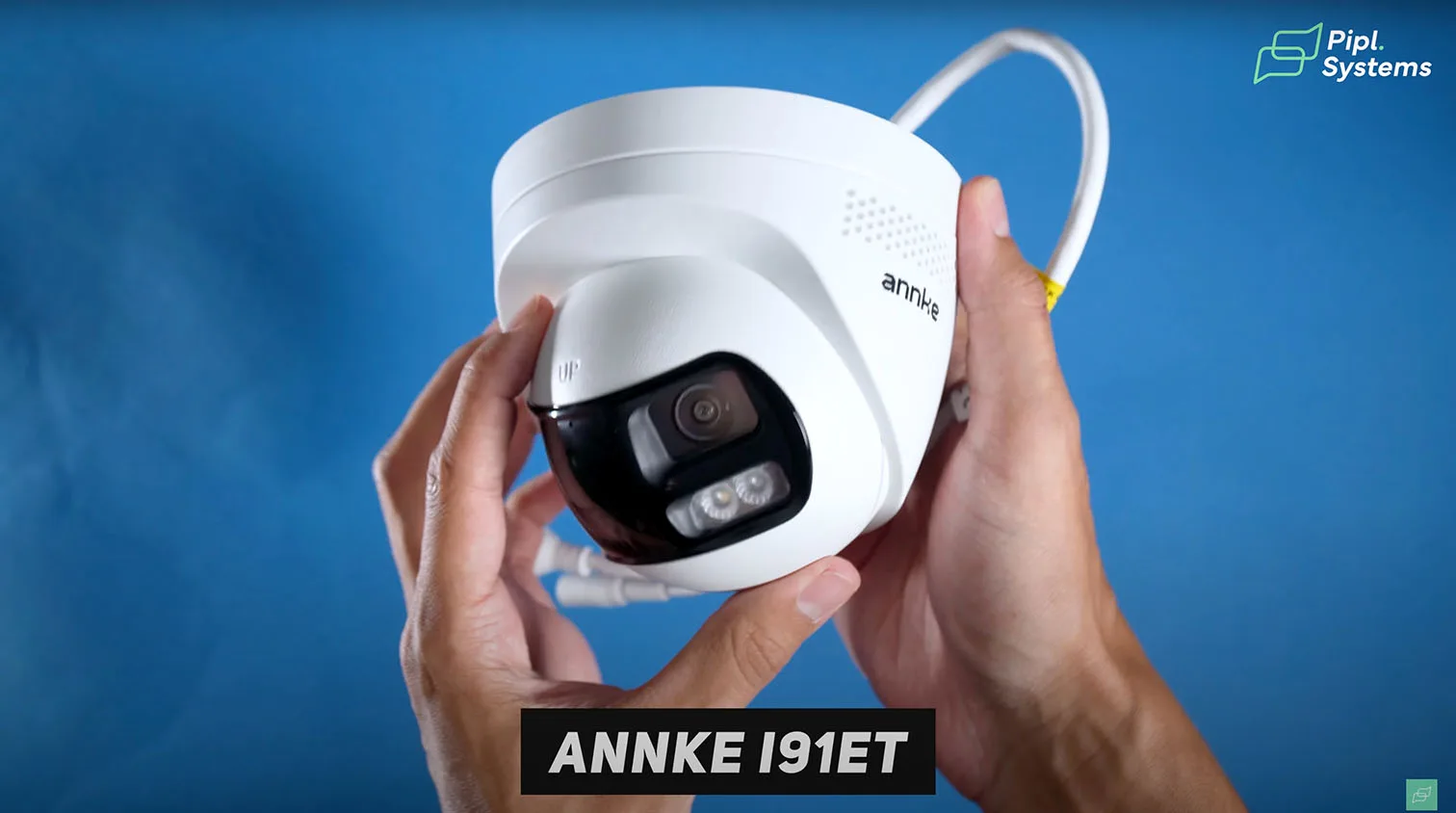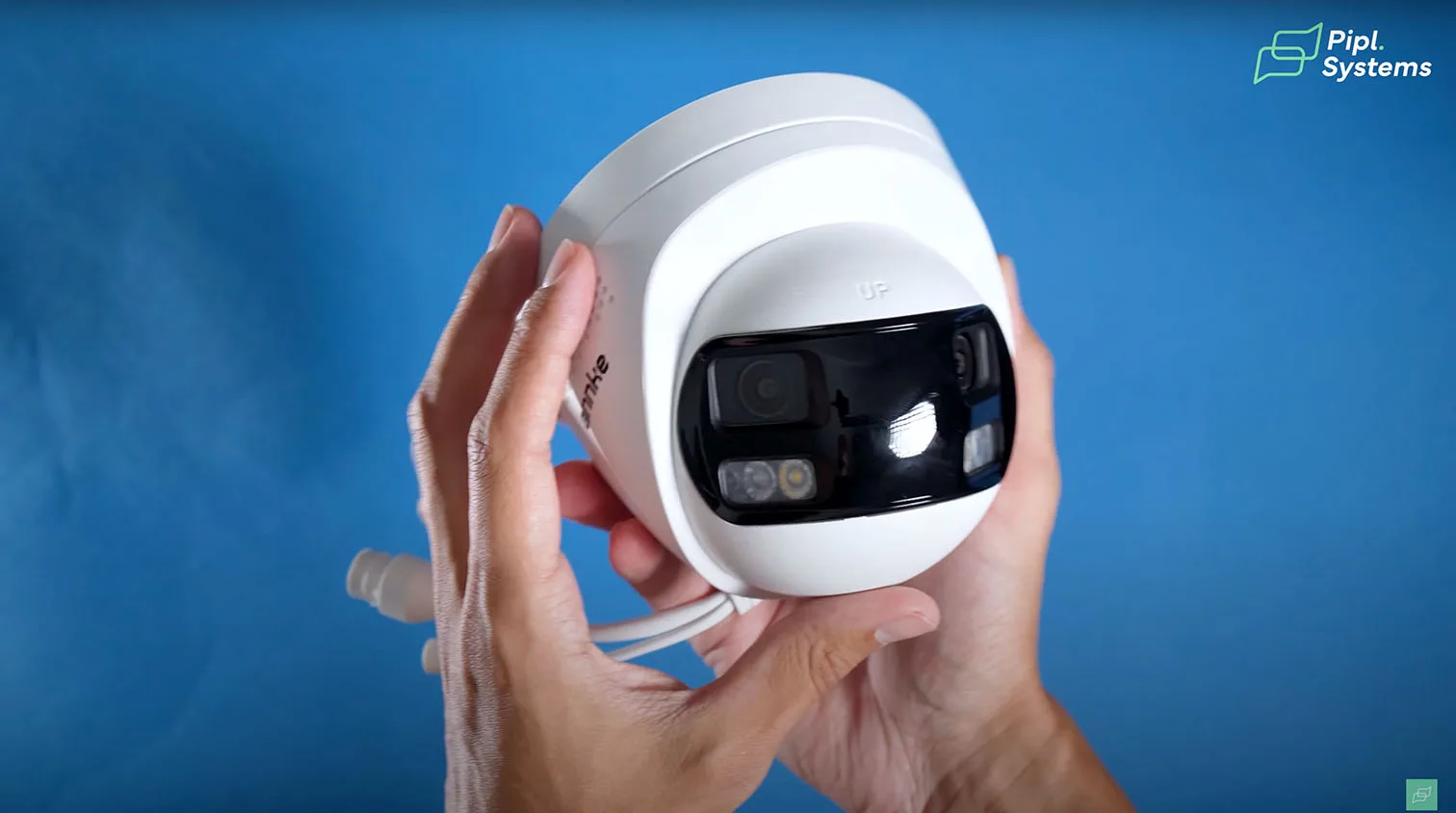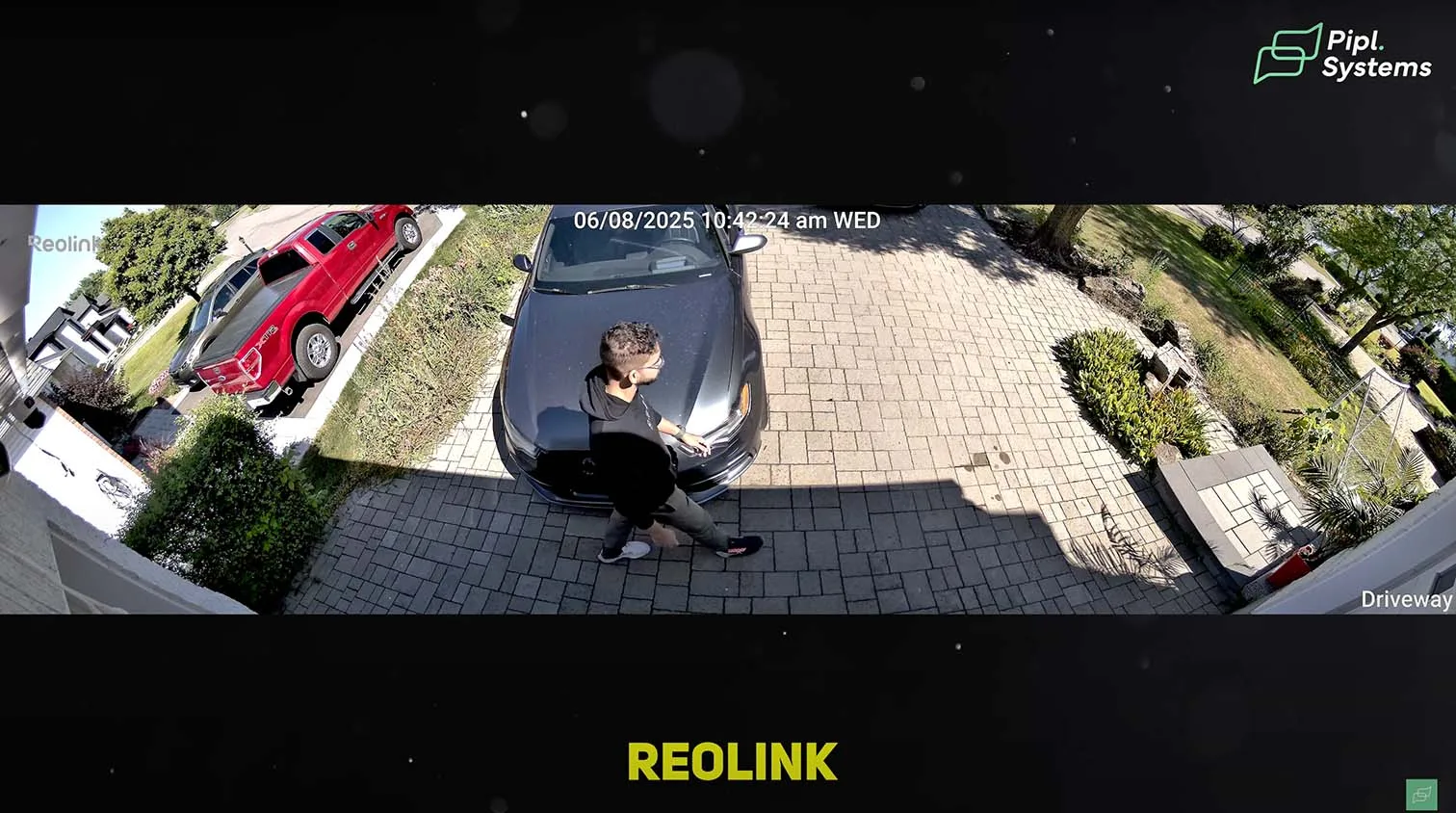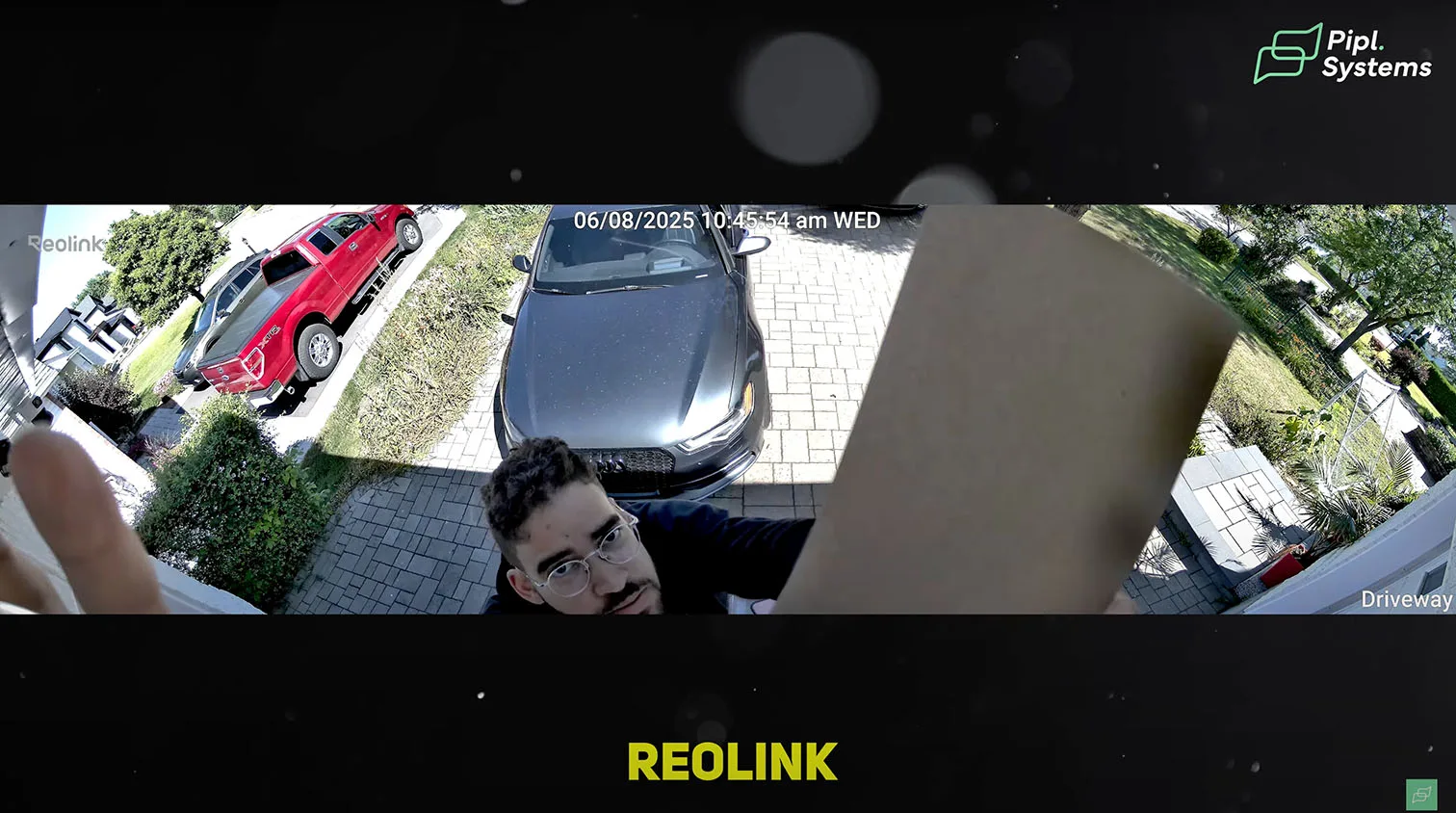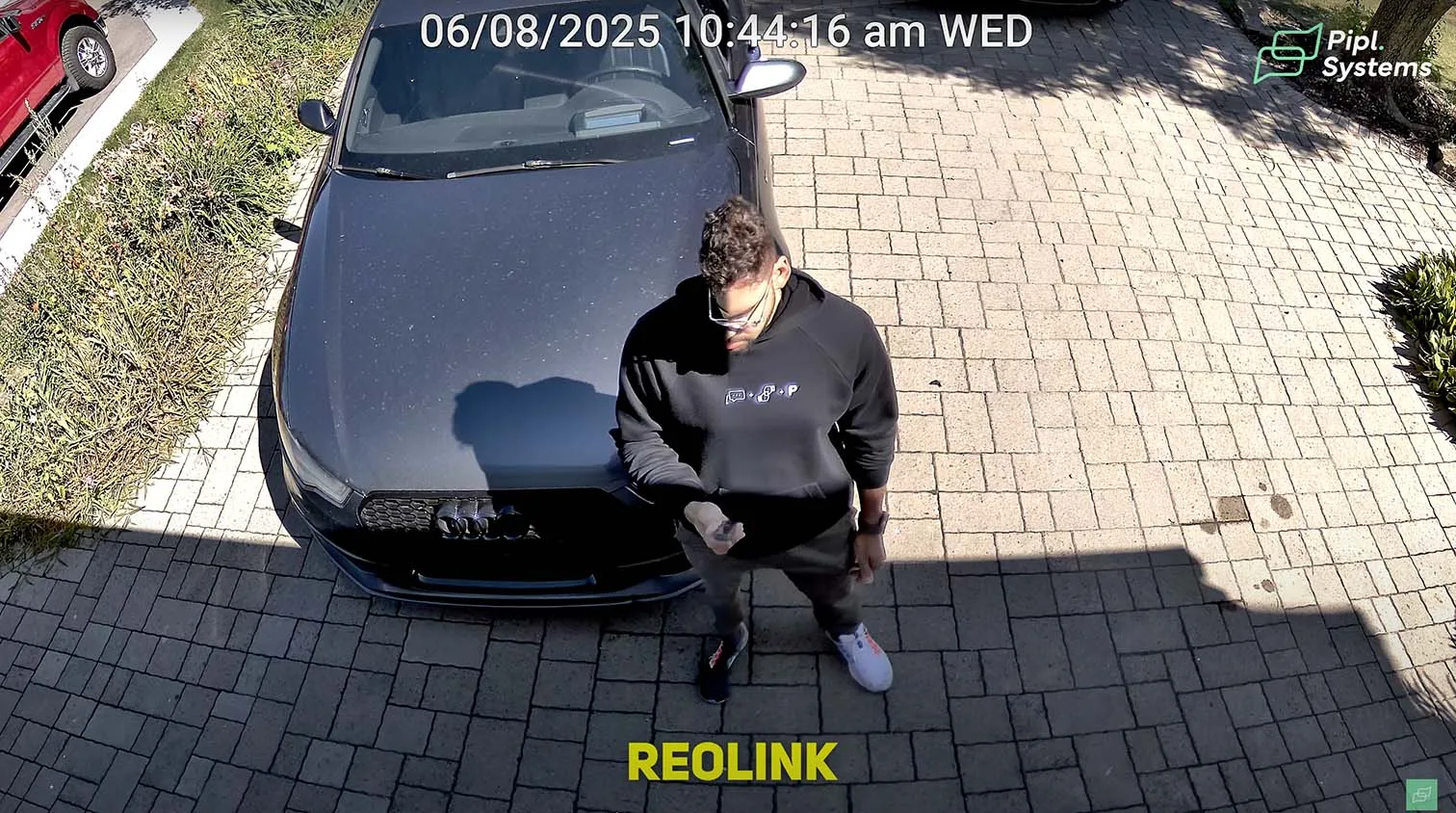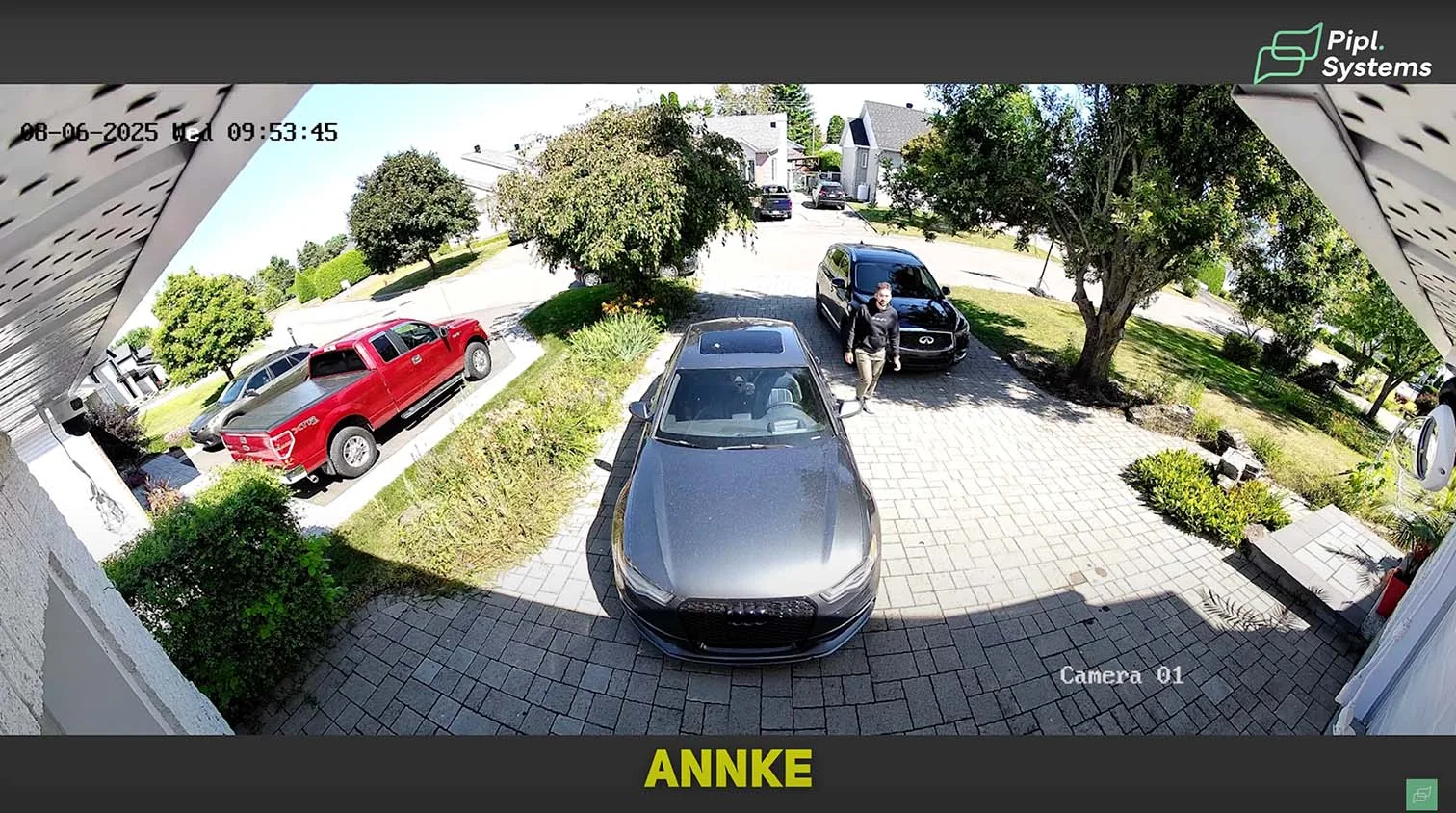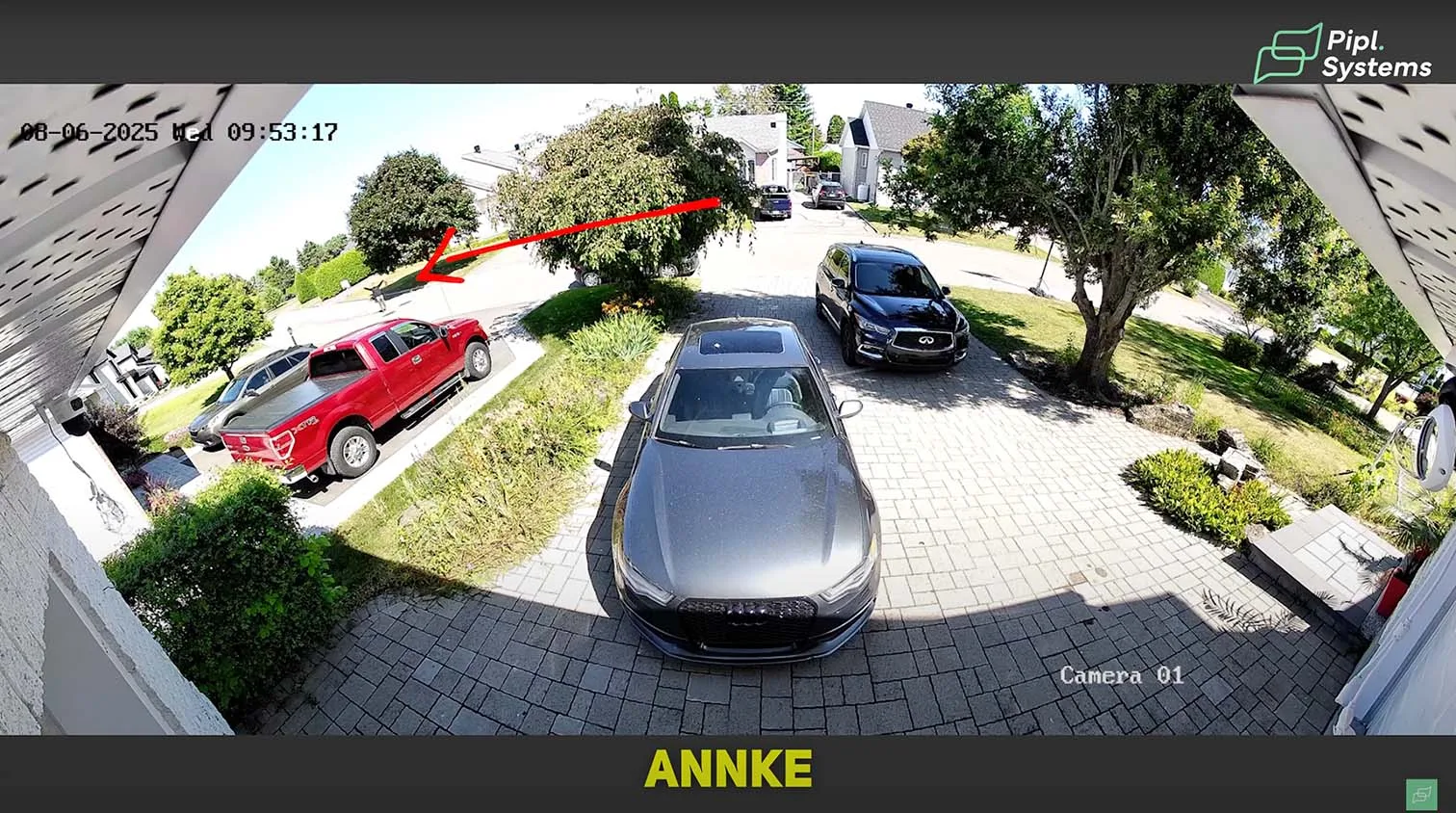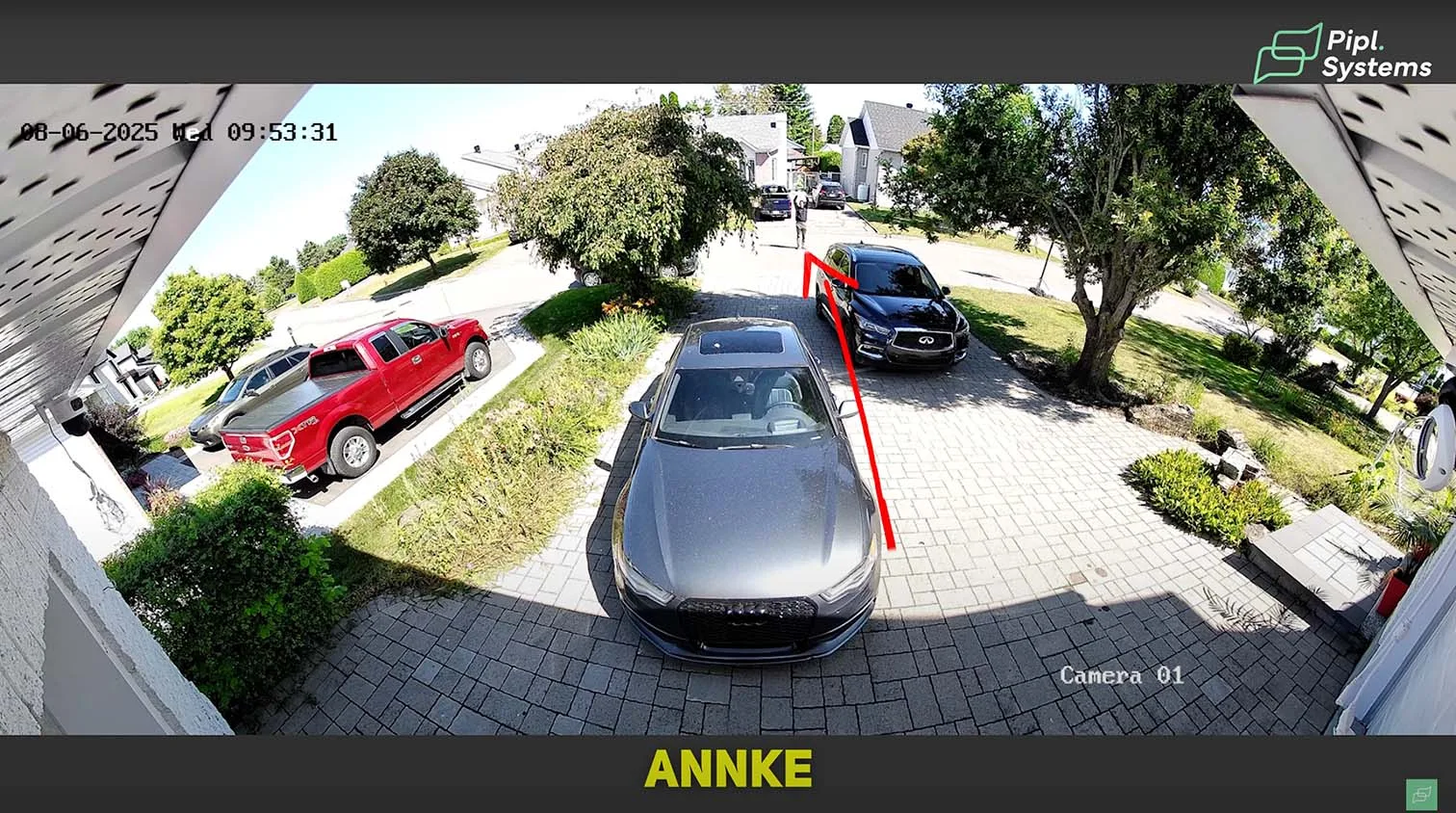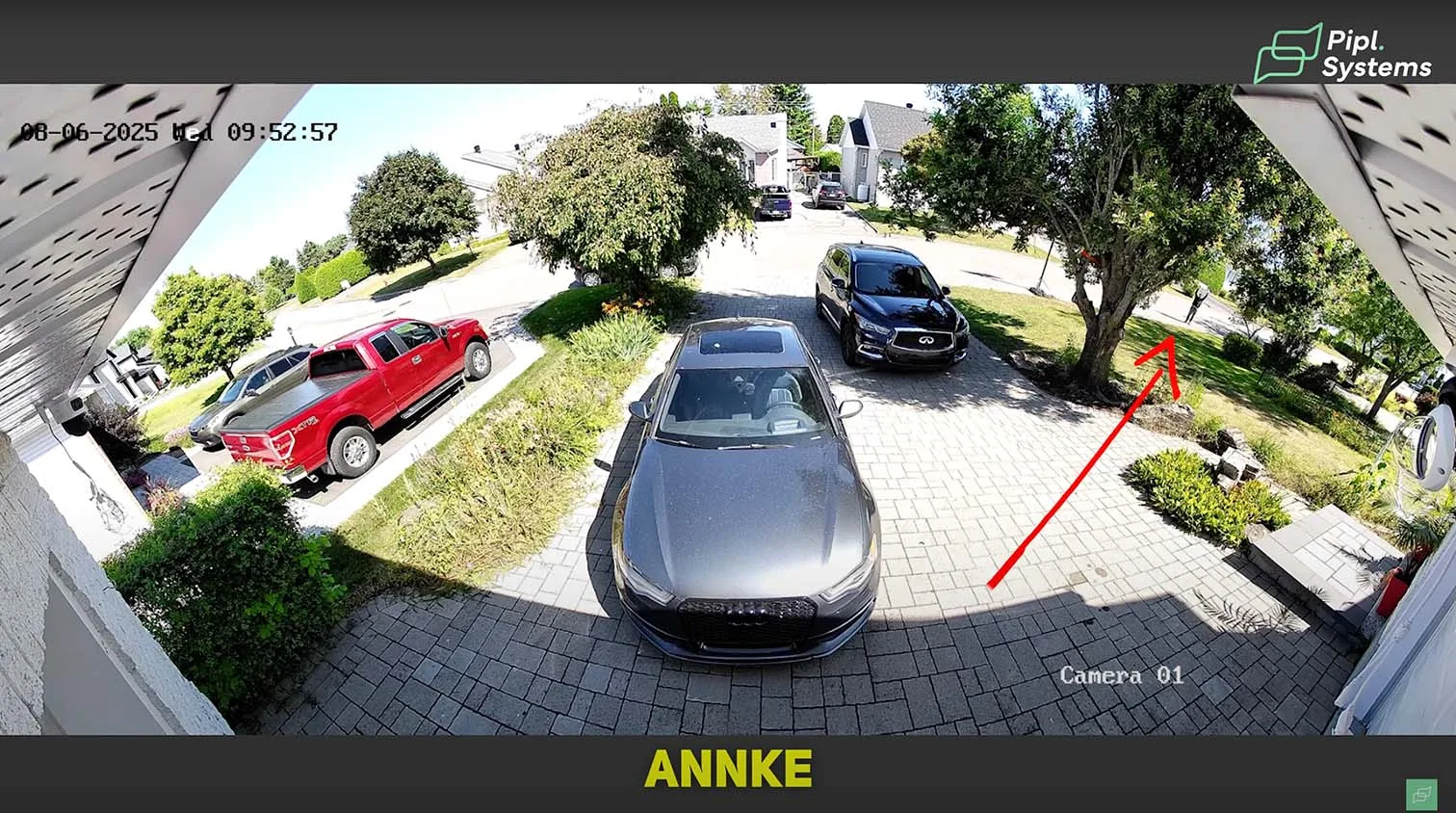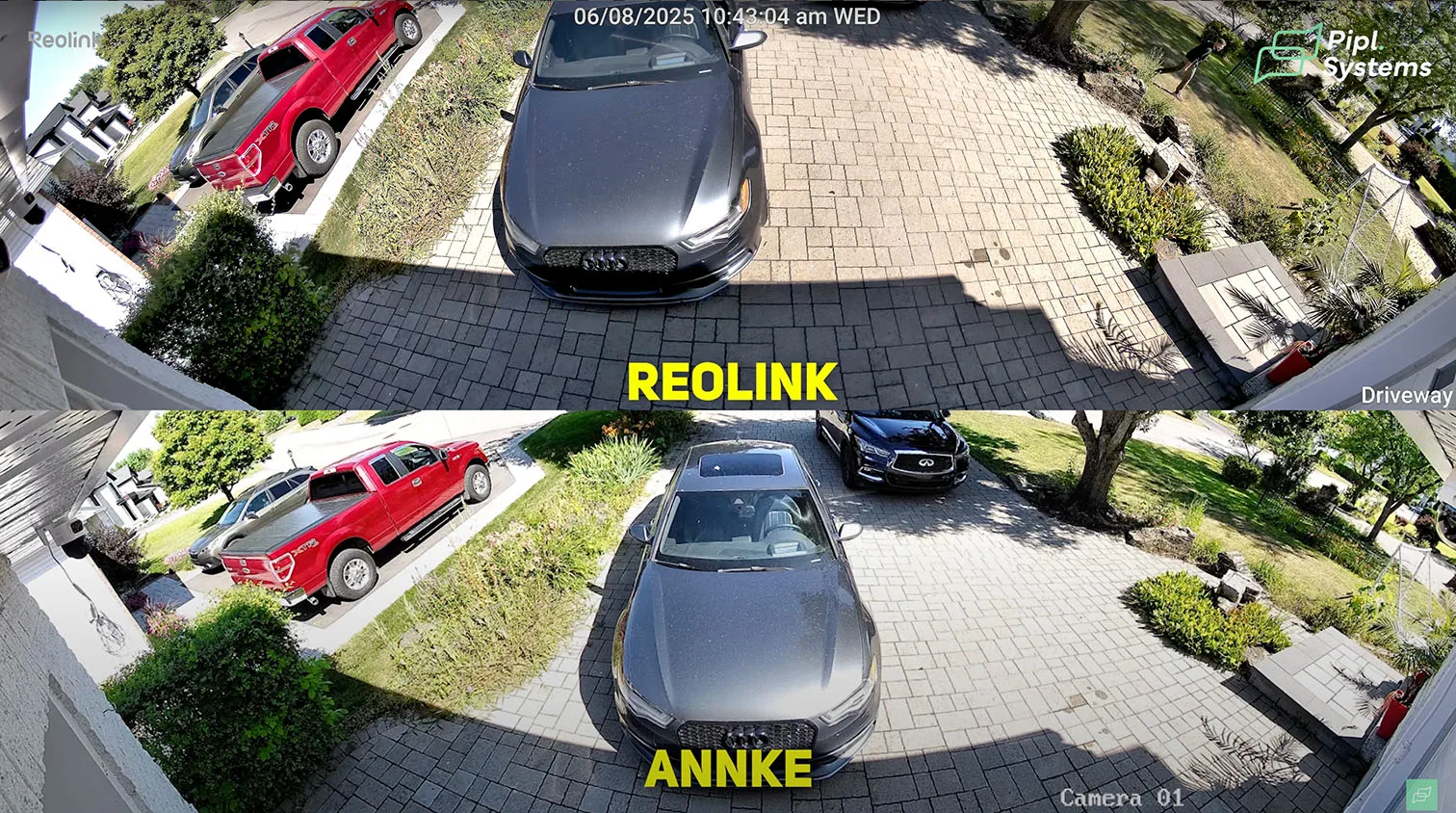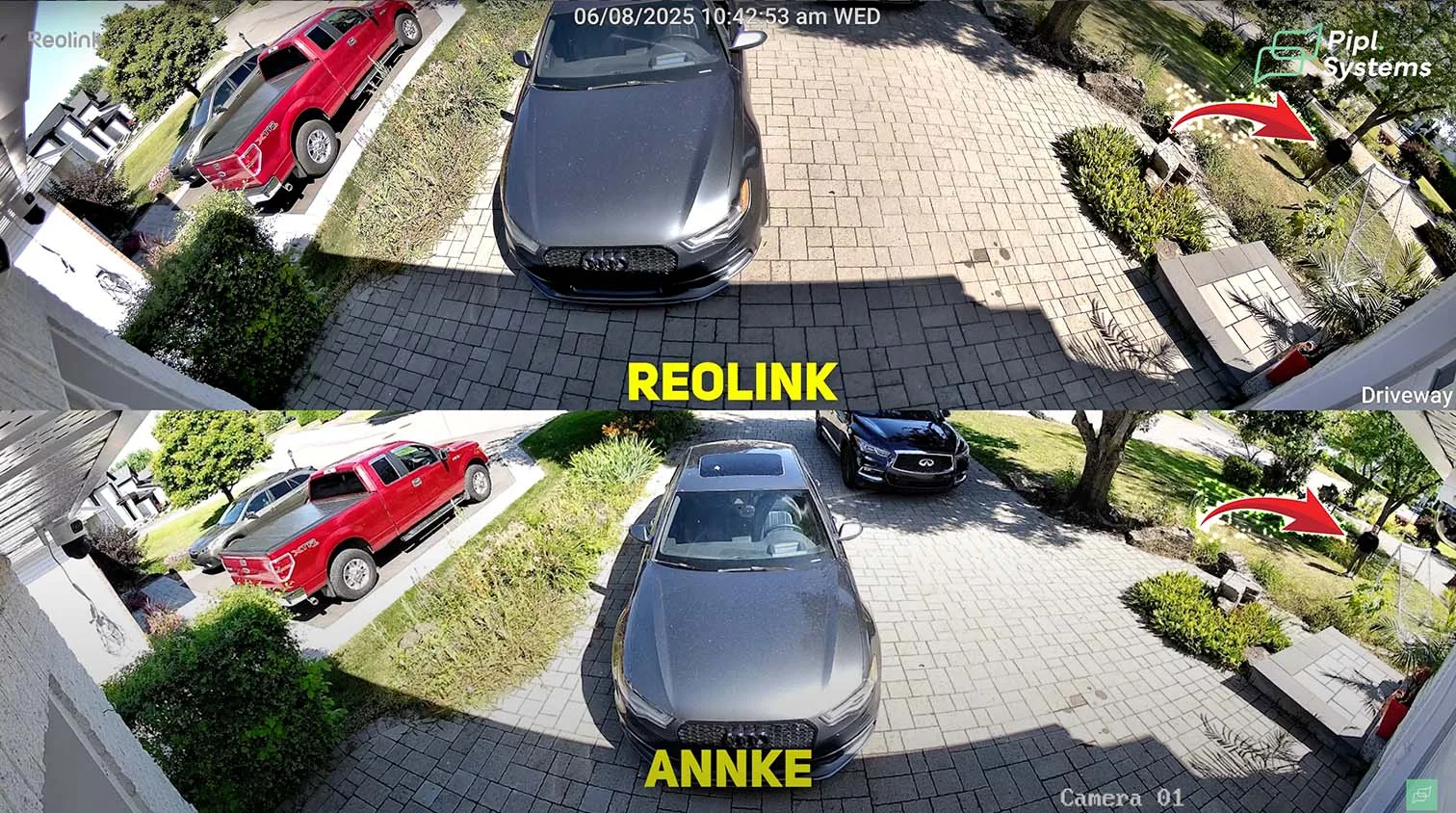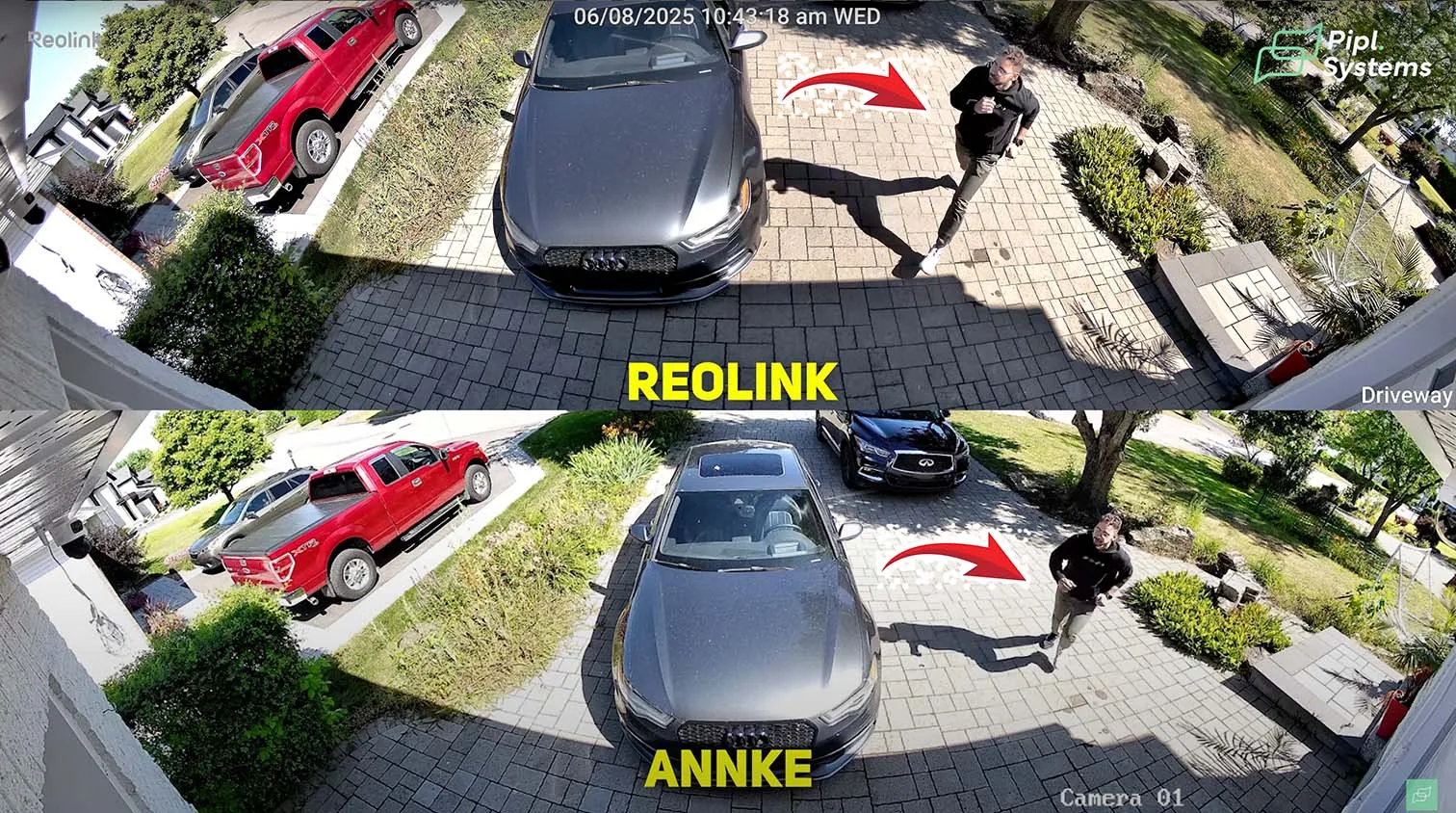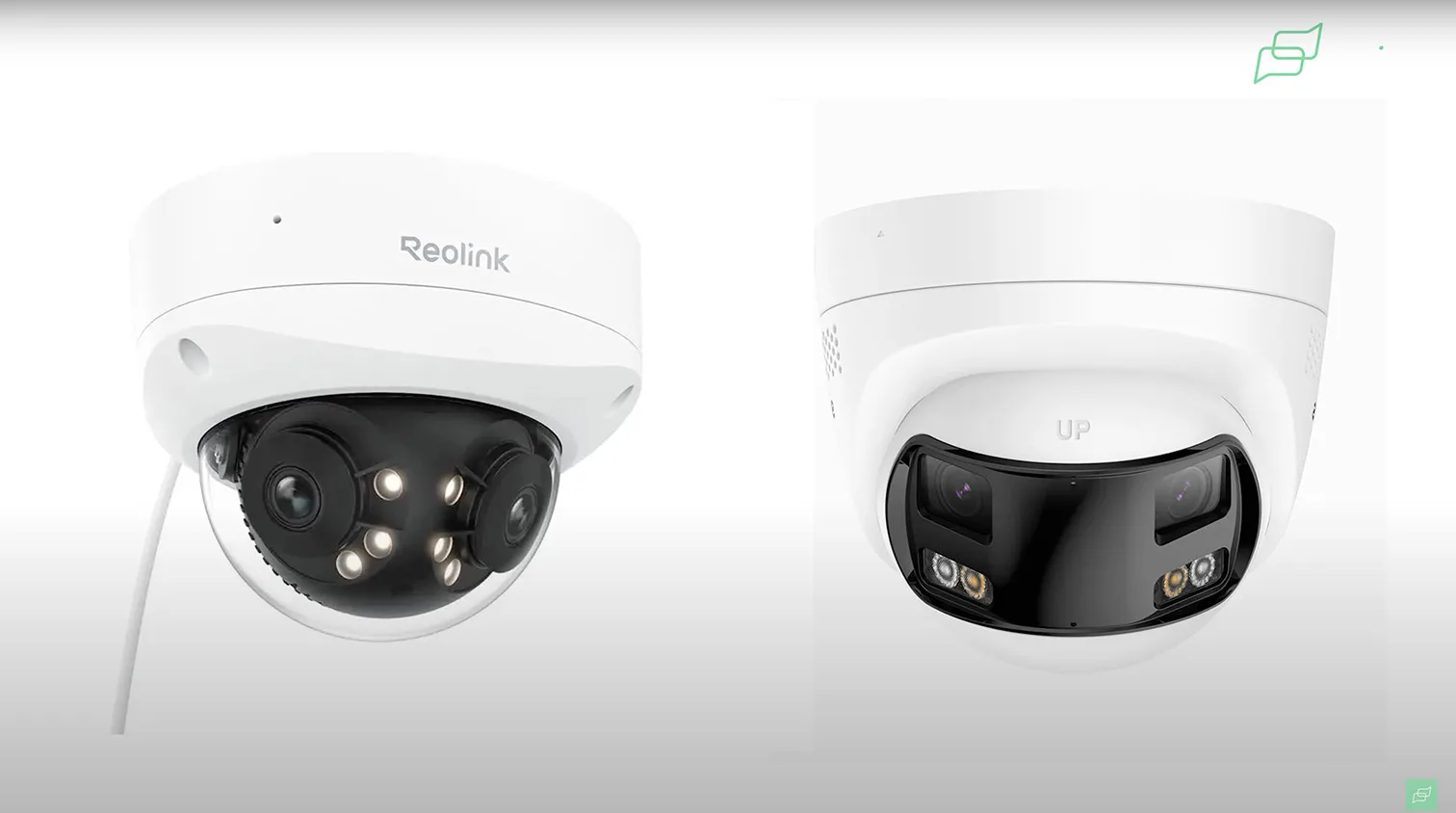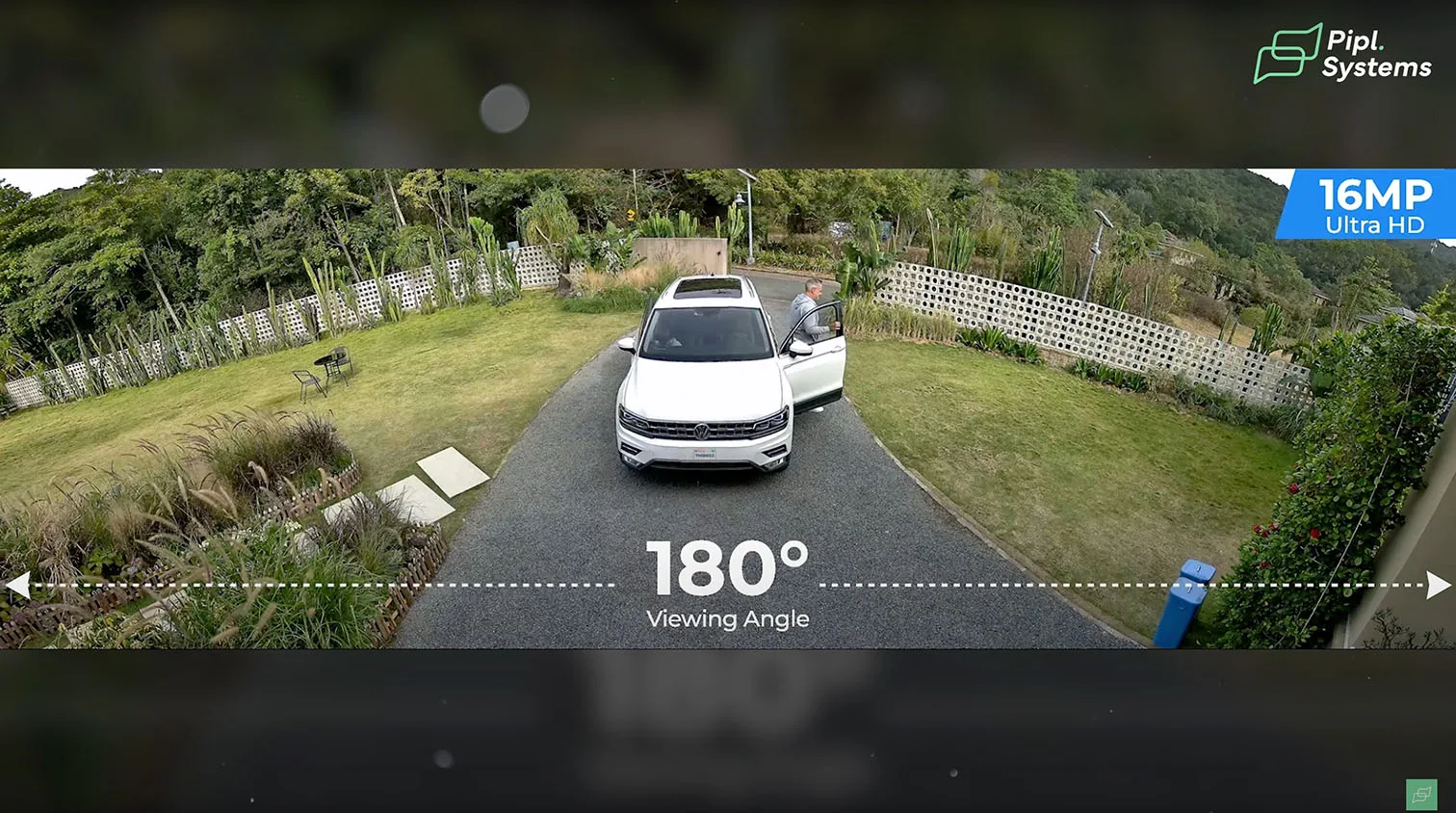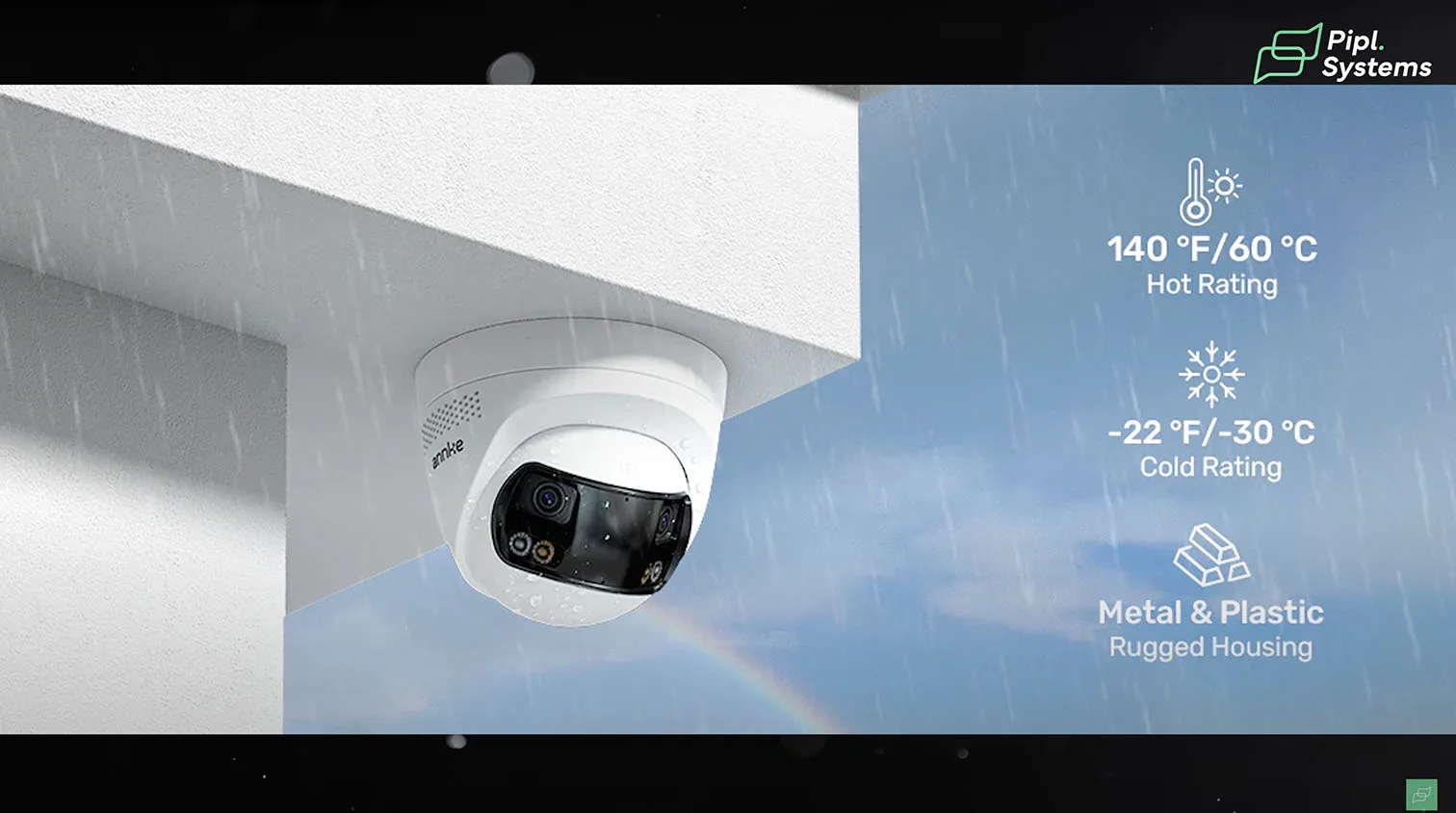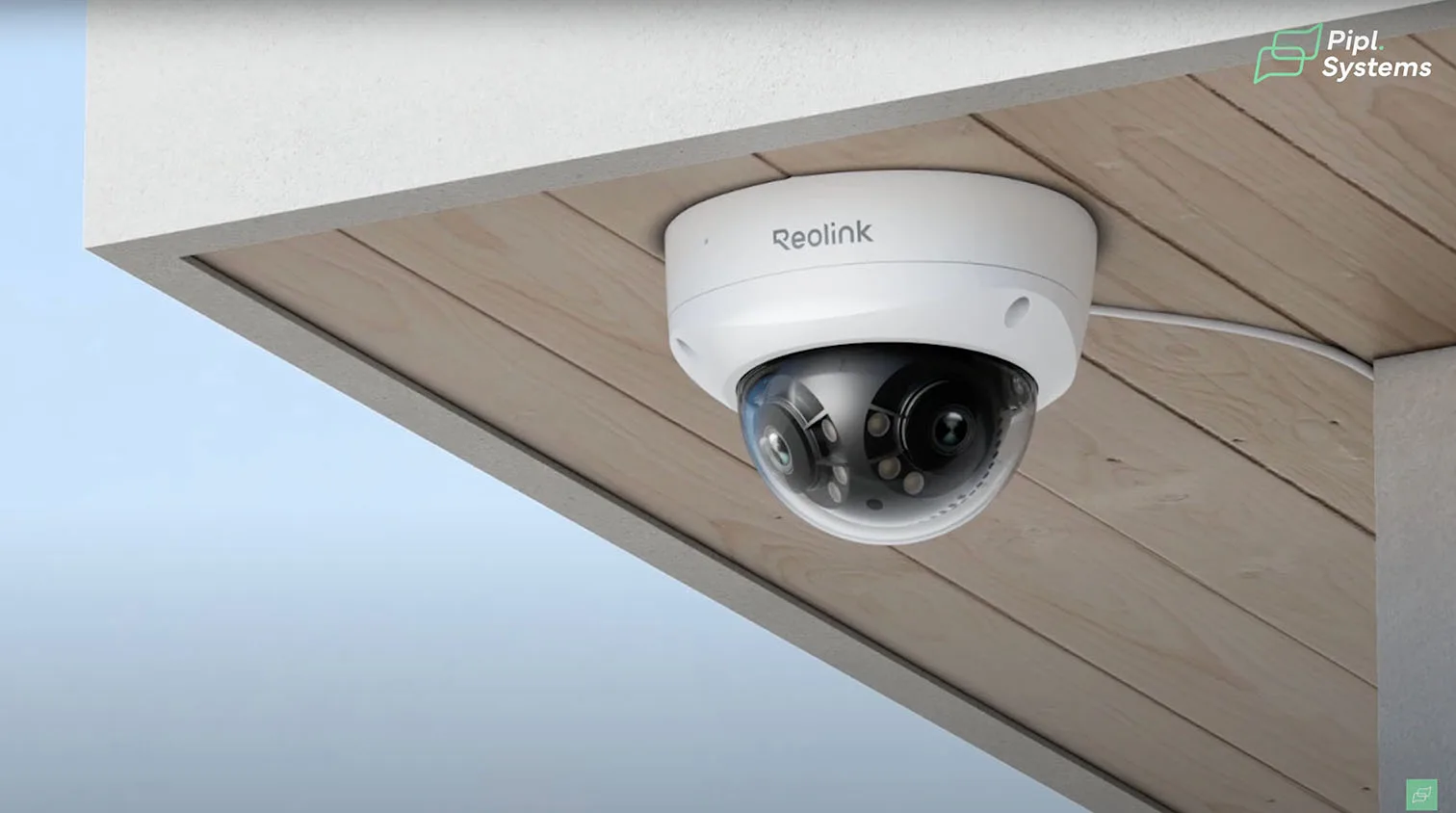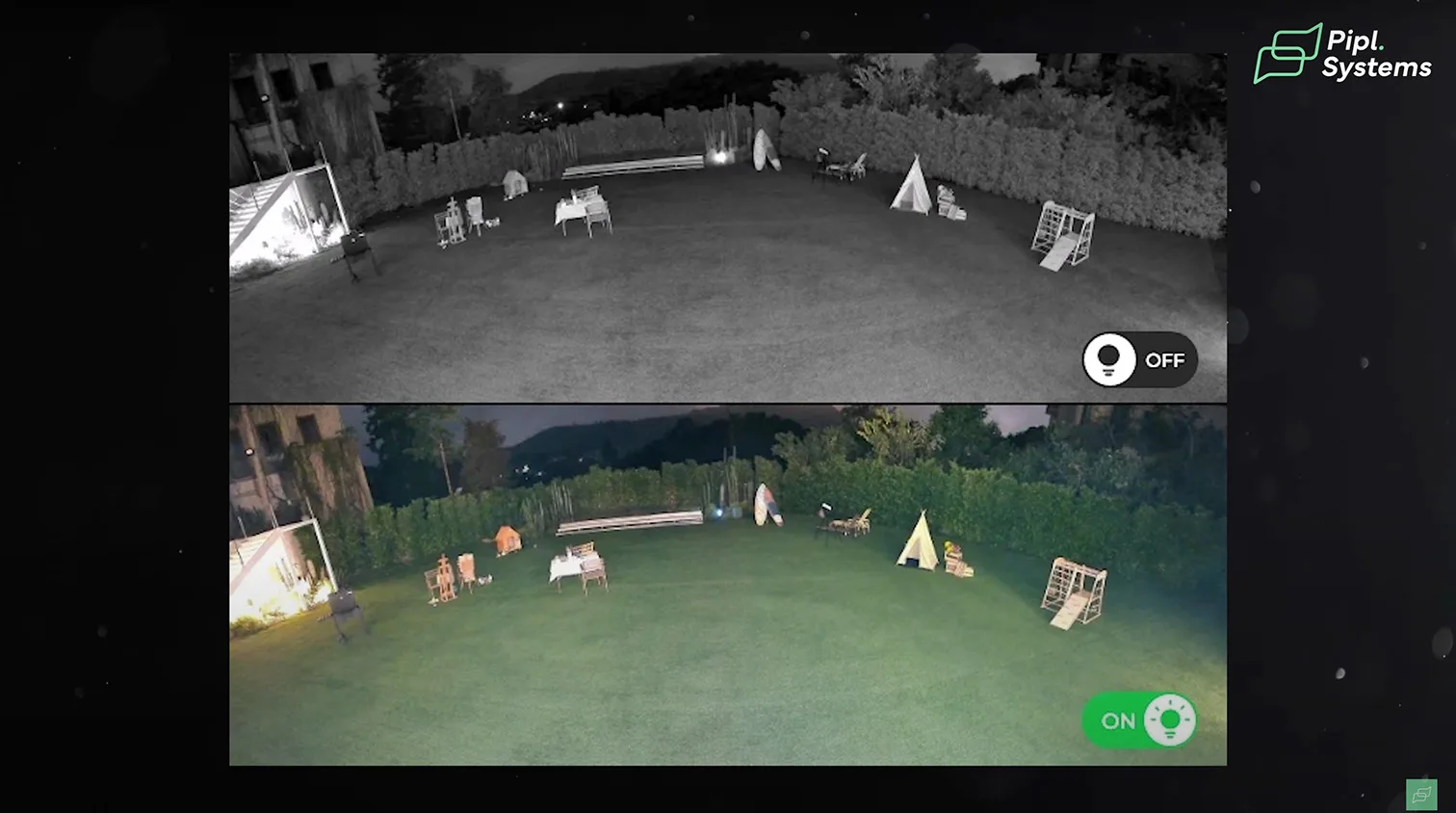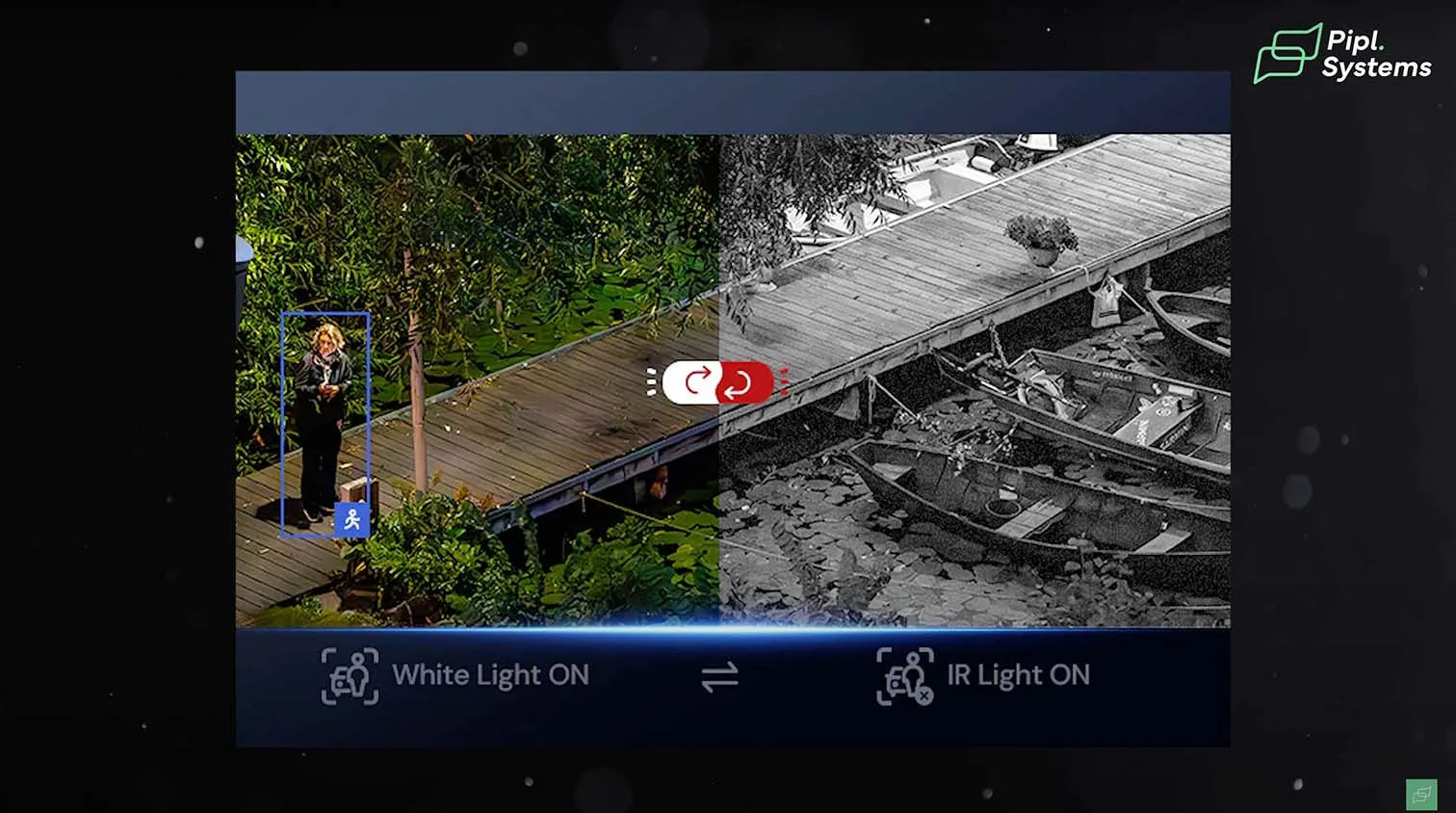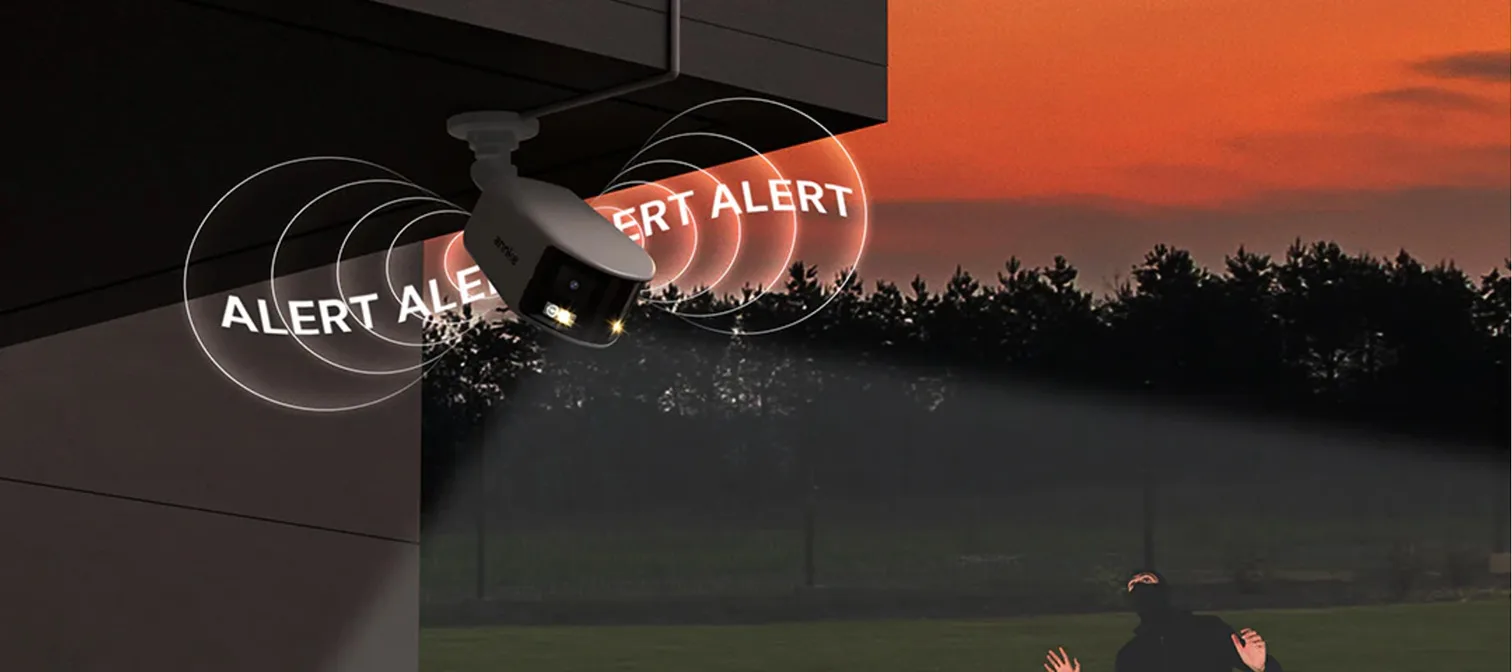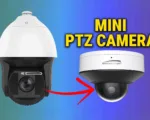Intro: Dual-Lens Cameras in 2025
Why dual-lens panoramic cameras are gaining popularity
Dual-lens panoramic cameras place two sensors in one housing and stitch the images into a seamless 180° view. You get the full front of a home or storefront in a single frame, so you’re not juggling two camera angles, two cables, or two channels on your recorder. The trade-off is minor seam distortion if someone moves slowly through the stitch line, but in day-to-day use, the situational awareness far outweighs that quirk.
First use of core terms
In our studio tests with Reolink and ANNKE dual-lens panoramic cameras, we saw why dual-lens cameras have momentum in 2025: fewer devices to mount, one PoE drop, and instant context when reviewing incidents.

How this technology fits both homeowners and SMBs
Homeowners get clean installs and wide coverage of the driveway, entry, and sidewalk without blind spots. SMBs cover long facades, loading zones, and parking edges with one logical stream – simplifying storage, licensing, and exports. For best results, pair a panoramic unit for awareness with at least one narrow-FOV camera where you need fine detail (faces, plates) at a distance.
Benefits of Panoramic Dual-Lens Cameras
Constant 180° panoramic coverage vs. multiple fixed cameras
A single stitched frame keeps the entire scene visible as events unfold left-to-right. You avoid the “handoff gap” between two single-lens cameras and review one timeline instead of two. During evidence pulls, that unified clip saves time and prevents context loss.
Savings on channels and wiring with PoE
Two sensors behave like one camera stream. You pull one cable, use one PoE port, and occupy a single NVR channel. On mid-size jobs, that means more free channels for specialty angles (LPR, cash wrap) and a leaner switch budget.
Professional insight on real-world use cases
Front facades, long driveways, fence lines, and wide storefront glass benefit most. A fixed 180° view is ideal when you must see both the “approach” and the “exit” simultaneously – something a PTZ can miss while tracking or patrolling.
Reolink 16MP UHD with 180° Panorama
Reolink’s Duo-class panoramic design stitches two 8MP sensors (2.8 mm) into a 16MP frame at up to 20 fps. In practice, you get strong day detail, IR plus spotlight-assisted color night options, and simple PoE wiring. The dome form factor with IK-level impact resistance works well near low soffits or exposed entries where vandal resistance matters.
ANNKE 16MP Ultra HD with Smart Dual Light
ANNKE’s 16MP panoramic approach also uses dual 8MP sensors (2.8 mm) but adds Smart Dual Light (IR/white light), 120 dB WDR for harsh backlight, and two-way audio. Edge storage up to 512 GB and robust codec support make it flexible for mixed-vendor NVRs and cloud bridges. It’s a strong pick for storefronts or gates that flip between low-light and full sun.
Are dual-lens cameras good for home security?
Yes – especially when you’d otherwise install two fixed units to cover the same frontage. Expect minor seam artifacts at the stitch line and lower pixel density per subject than a tight single-lens view. Mitigate that by placing the camera where critical interactions happen within 20–30 feet and supplementing with a narrow-FOV camera for identification at a distance.
Easy Installation and Simpler Wiring
One PoE run powers two sensors
Dual-lens panoramic models route both sensors through a single network interface. You pull one Cat5e/Cat6 cable, connect to one PoE port, and occupy one NVR channel. In practice, that means:
- Faster installs on soffits and eaves with less drilling and sealing
- Simpler switch sizing (one port vs. two)
- Cleaner recorder layouts with a single stream to review
Typical power is within standard PoE (802.3af). In our tests, Reolink Duo 3V PoE stayed under 12 W, and ANNKE I91ET peaked around 11.5 W, so most PoE switches handle them without issue.
Dome vs. turret vs. bullet: picking the right form factor
- Dome: Best for discreet coverage and vandal resistance. The smoked or clear bubble conceals the twin lenses, so passersby can’t easily tell you’re capturing a 180° view. Great for entries and lobbies.
- Turret: Exposed lenses, easy to aim, low glare. A solid all-rounder for soffits and garage faces where you want quick adjustments after install.
- Bullet: Most visible deterrent and plenty of accessory mounts. Works well on long walls and fence lines, though the dual optics are obvious.
Pro tip: Place the stitch line down the least important zone (for example, the center of a blank wall) to minimize the chance you’ll notice small seam artifacts when someone moves slowly across it.
ANNKE vs. Reolink install experience
- Reolink Duo 3V PoE: Compact footprint with an IK10 vandal-resistant dome option and IP67 weather sealing. Mount plate, cable through, land the RJ45, aim the horizon, done. The spotlight/IR combo makes nighttime focus easy to verify during setup.
- ANNKE I91ET: Turret-style housing with IP67 weather protection and Smart Dual Light (switches IR/white light). The onboard mic/speaker is handy for aiming and for post-install two-way audio. Its flexible codec and ROI settings help on mixed NVR deployments.
Both support local microSD and standard RTSP streams, so you can validate video with a laptop before you button up the mount.
IK10 vandal resistance and IP67 weatherproofing
For exposed installs, vandal and weather ratings matter. The Reolink Duo 3V PoE carries IK10 and IP67, a strong combo for low-height entries and alley walls. The ANNKE I91ET is IP67 (dust- and water-resistant) with a sturdy metal/plastic chassis. If you anticipate tampering, prefer domes with higher impact ratings and use security screws on the base.
Where to Install Panoramic Cameras at Home
Front entrances, garages, and driveways
A single 180° view can cover the walkway, porch, package zone, and a slice of driveway at once. Mount slightly offset from the door (8–10 ft high), level the horizon, and keep the stitch line away from the primary approach path. For driveways, center the camera to capture both curb approaches so vehicles entering from either direction remain in frame.
Backyards, side yards, and fence lines
Panoramic coverage shines along long fences and yard edges where two fixed cameras would otherwise be required. Place the unit so the stitch line meets the fence mid-span, and ensure nearby branches or lights don’t sit directly against the dome or turret visor.
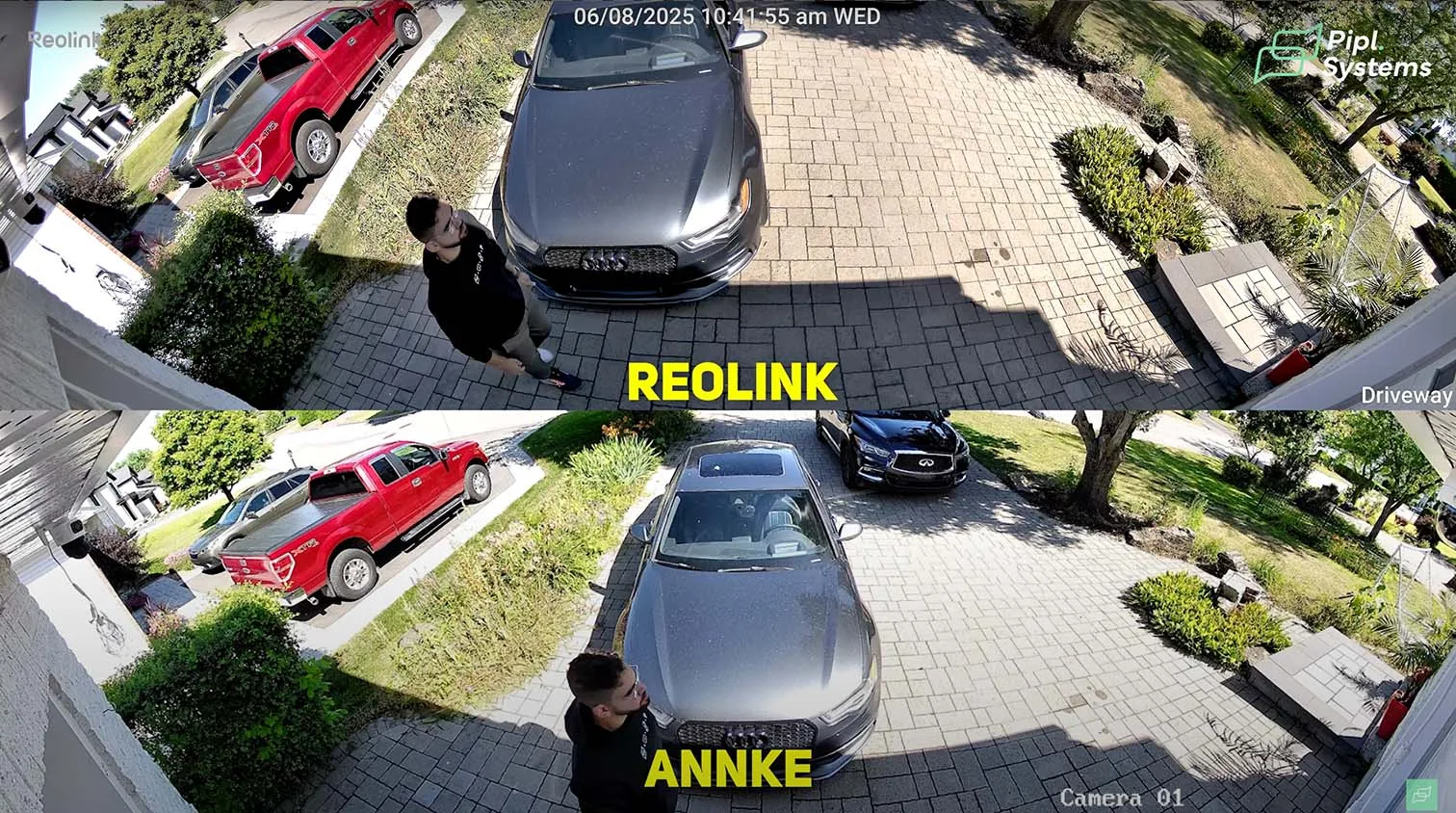
Business storefronts and warehouse entrances
SMBs benefit from continuous context across a facade: doors, display windows, sidewalk traffic, and the loading nook all in one stream. Pair a panoramic with a narrow-FOV camera aimed at the cash wrap or a gate for high-detail identification, while the 180° unit preserves the storyline of how people approached and left.
Residential vs. SMB priorities
- Residential: Clean aesthetics, minimal cabling, and broad awareness at the porch and driveway. Privacy masks are often used to shield neighbors’ property or public sidewalks.
- SMB: Deterrence and audit trail. Smart lighting (IR/white), two-way audio (ANNKE), and higher WDR performance help with glass glare and mixed lighting. Footage export and unified timelines speed incident review.
If you’re replacing two fixed cameras, confirm that the dual-lens pixel density at your critical distance (20–30 ft for faces, closer for plates) still meets your needs. When you need both panorama and high-detail identification, keep the dual-lens unit for context and add one tight-angle camera where it counts.
Dual-Lens vs. PTZ Cameras
Strengths and weaknesses of PTZ motion tracking
PTZ units shine when you need to follow a subject or zoom in for detail. Presets, patrols, and auto-tracking let you sweep wide areas and punch in for plates or faces. The trade-offs are real: a PTZ only records where it’s pointed, so when it’s tracking one person, you can miss what’s happening elsewhere. Most wall or corner mounts also reduce the practical field of view to about 180°, and higher torque motors typically require PoE+ or even PoE++ along with sturdier mounts. Over time, moving parts add maintenance.

When PTZ excels
Large lots, parking decks, and long fence lines are classic PTZ domains. Think guard-tour behavior, zooming down drive aisles, or watching a distant gate. High-pole installs with clear sightlines let a PTZ deliver details that a fixed panoramic cannot.
One of the standout releases in Reolink’s lineup is the Altas, a battery-powered camera that blends strong AI performance with practical installation. Designed for homeowners and small businesses who want advanced detection without complex wiring, it delivers reliable person, vehicle, and package alerts along with flexible placement options. If you’re considering this model for your own setup, you’ll find our hands-on walkthrough invaluable: Reolink Altas Full Review: Installation, Setup, and Live Demo Guide.
When dual-lens panoramic cameras are superior
Dual-lens panoramic cameras lock down a constant 180° context with no pan-away blind spots. For front entrances, driveways, storefronts, and loading doors, that uninterrupted view is often more valuable than motion tracking. You also get a simpler bill of materials: one PoE run, one channel on the recorder, and no motorized parts to tune or service.
Cost, PoE, and recorder limitations
Comparable PTZs generally cost more and draw more power, often needing 802.3at or PoE++. Dual-lens models like the Reolink Duo 3V PoE and ANNKE I91ET run on standard PoE (802.3af) and are easier on switch budgets. Plan storage carefully, either way: a stitched 16MP panoramic stream is heavier than a single 4K feed. In our lab, Reolink’s default main stream sits around 10 Mbps (adjustable), while ANNKE can push higher bitrates when you enable WDR and Smart Dual Light. Make sure your NVR has headroom for continuous panoramic recording.
If you’re considering expanding your setup beyond dual-lens panoramic models, it’s worth taking a broader look at Reolink’s ecosystem. Their latest lineup ranges from compact indoor Wi-Fi cameras to rugged PoE and LTE solutions built for larger properties. Each product comes with different strengths in image quality, storage, and smart detection, so choosing the right one depends on your space and security goals. For a detailed breakdown of the best options available this year, you can explore our full guide here: Reolink Security Cameras in 2025: Full Buyer’s Guide.
Choosing Your Dual-Lens Cameras
Lens and field of view
Both the Reolink Duo 3V PoE and ANNKE I91ET use 2.8 mm lenses to produce a seamless 180° horizontal panorama. Vertical field of view differs: Reolink is about 53°, which concentrates pixels along the horizon for porches and driveways, while ANNKE reaches roughly 77°, helpful near tall vestibules or storefront glass.
Night vision options
Reolink’s integrated spotlights enable true color night video (4500K, 540–840 lumens) with IR backup at 850 nm. ANNKE’s Smart Dual Light switches intelligently between IR and white light up to 30 m and can strobe on events; paired audio warnings add deterrence at the door.
Local storage and retention
ANNKE supports microSD cards up to 512 GB; Reolink supports up to 256 GB. For motion-only recording, that difference can add meaningful days of retention. If you need 24/7 capture, favor an NVR and use the card as a redundancy buffer.
Integration with Reolink NVR and ANNKE NVR
Both cameras speak RTSP and ONVIF, so they integrate cleanly with their native NVRs as well as many third-party recorders and VMS platforms. Reolink’s Duo 3V PoE plugs into Reolink NVRs with minimal setup, and ANNKE’s I91ET benefits from H.265+ efficiency on ANNKE NVRs. Each occupies a single channel despite the two sensors.
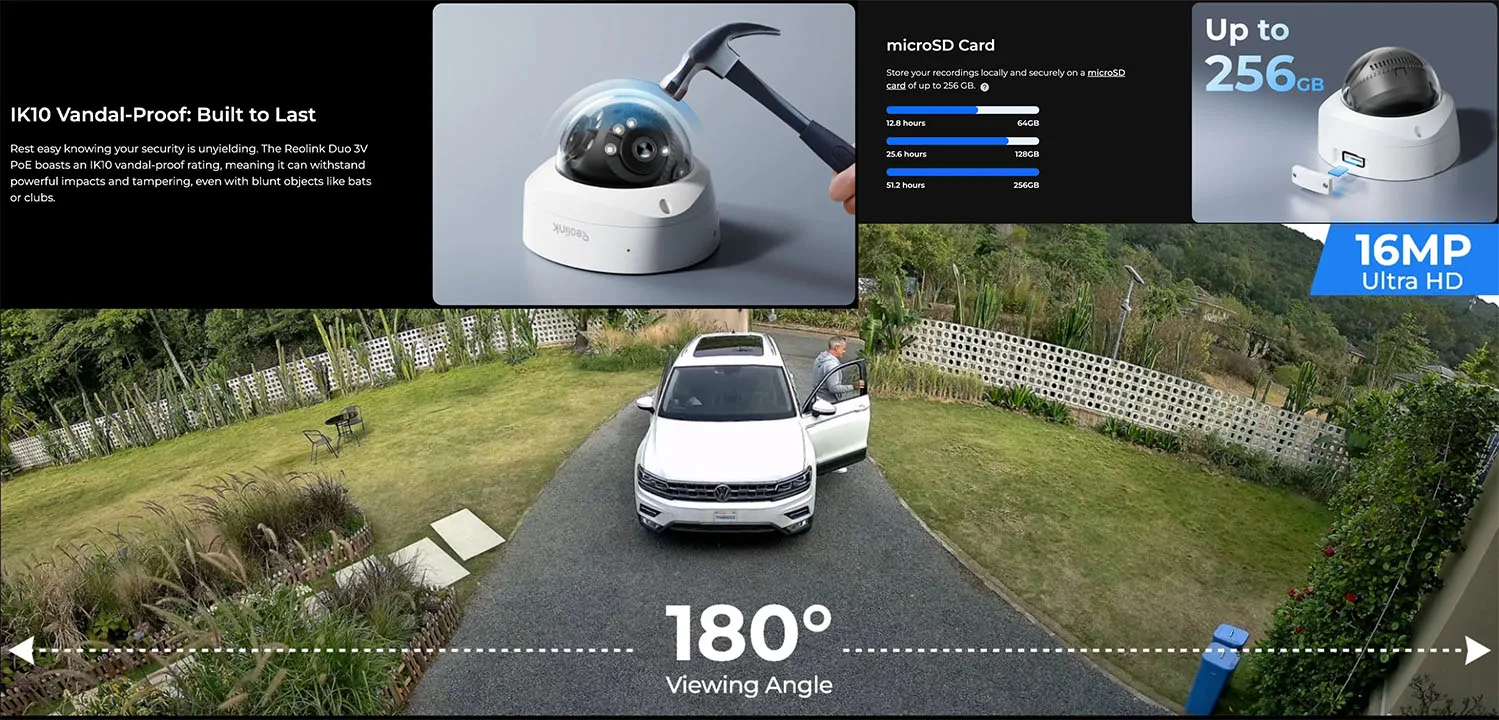
Reolink Duo 3V PoE – Pros and Cons
Pros
• 16MP panoramic output with crisp 180° coverage
• IK10 vandal resistance and IP67 weather sealing for low-height installs
• Spotlight color night vision, two-way audio, time-lapse mode
• Straightforward app and NVR integration; standard PoE power
Cons
• 20 fps max can limit motion smoothness in fast scenes
• 256 GB microSD ceiling may constrain local-only retention
• Narrower vertical FoV than ANNKE, which can matter near tall entries
ANNKE Dual Lens 180° – Pros and Cons
Pros
• 16MP Ultra HD with 120 dB WDR for backlit doors and windows
• Smart Dual Light (IR/white) to balance discretion and deterrence, plus audio/strobe alarms
• On-camera analytics for human/vehicle classification
• Built-in mic/speaker and microSD support up to 512 GB
• Broad codec options and flexible bitrate controls
Cons
• Not IK10; metal/plastic housing is sturdy but less impact-rated than dome variants
• 20 fps max frame rate and higher bitrates when features are enabled require NVR/storage planning

Verdict: Best Dual-Lens Panoramic Cameras in 2025
For vandal-prone entryways where color night vision and hardening matter, the Reolink Duo 3V PoE is an excellent fit. For glassy storefronts and mixed lighting where WDR, deterrent lighting, and larger onboard storage help, the ANNKE I91ET stands out. Both are among the best dual-lens panoramic cameras this year, and the right choice comes down to mounting height, lighting, retention needs, and how much vertical scene you want to capture. If our hands-on testing helped, the product links in the description let you support the lab at no extra cost while you pick the model that matches your site.

Pick up your Reolink Duo 3V PoE or ANNKE 8MP UHD Dual-Lens Outdoor PoE Security Camera (AN-I91ET0102) via our affiliate link:
What is a Dual-Lens CCTV Camera?
Dual-lens fusion and 180° stitching
A dual-lens panoramic camera houses two image sensors behind separate fixed lenses and fuses both streams into a single wide scene. The stitching engine aligns overlap and corrects perspective to deliver a continuous 180° horizontal view. In practice, this gives you the context of two cameras with one PoE run, one mount, and one recorder channel. Modern models like the Reolink Duo 3V PoE and the ANNKE I91ET output a 16MP Ultra HD panoramic frame by combining two 8MP sensors, which preserves detail across doorways, driveways, and storefronts without leaving blind spots when activity shifts left or right.
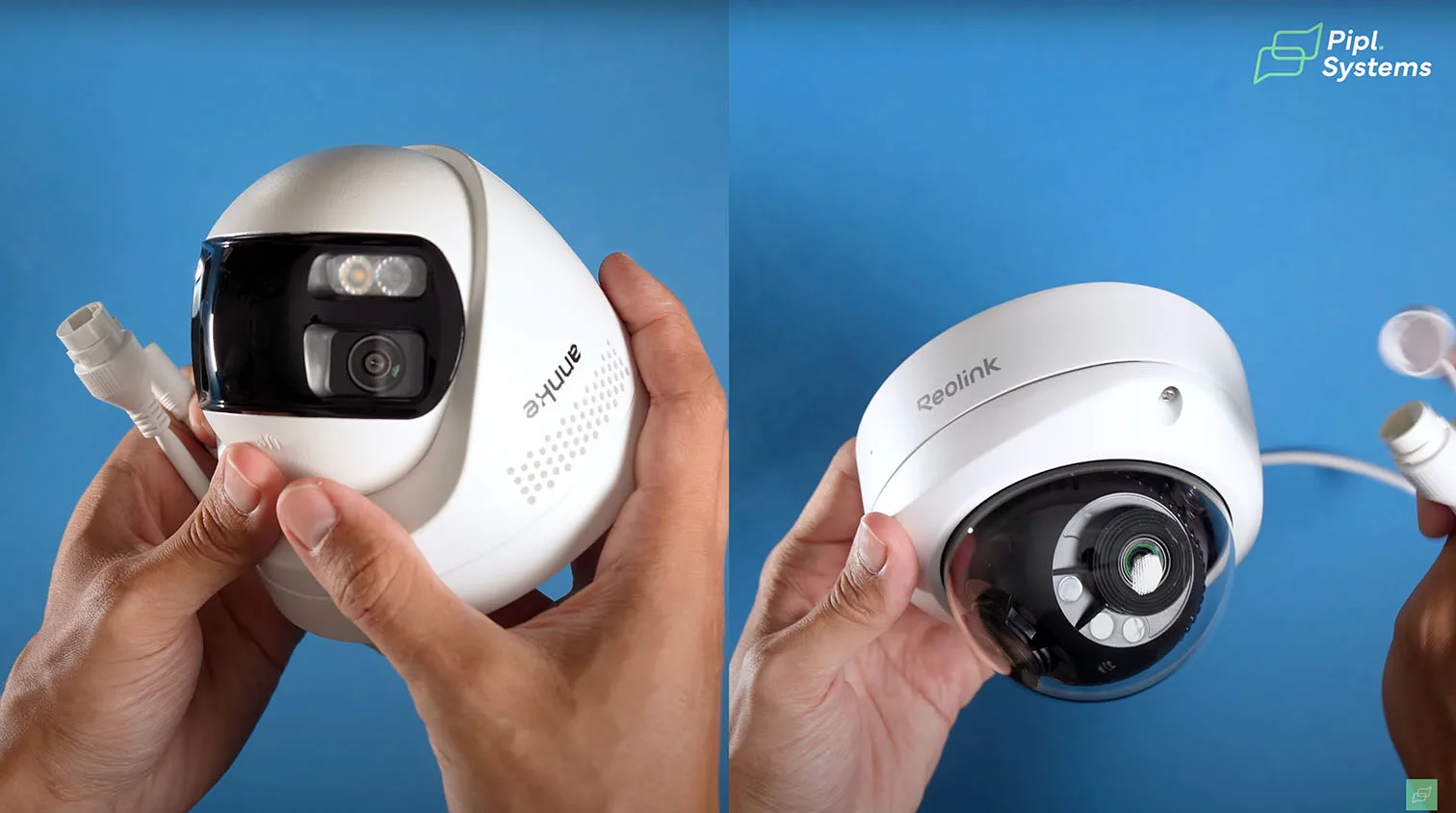
Dual-lens vs. multi-sensor vs. PTZ
Dual-lens panoramic cameras prioritize always-on coverage. You get the entire scene at once, which is ideal for entrances, parking aprons, and loading doors. Multi-sensor cameras use three or four sensors for 270° to 360° coverage and are best for large corners or building perimeters where you need even more wraparound context. PTZ cameras add motorized pan, tilt, and optical zoom, which is powerful for guard tours and long-range identification, but a PTZ only records where it is currently pointing. For most residential and SMB sites, dual-lens fusion is the sweet spot: constant 180° visibility, fewer cables, lower power draw, and no moving parts to adjust or service.
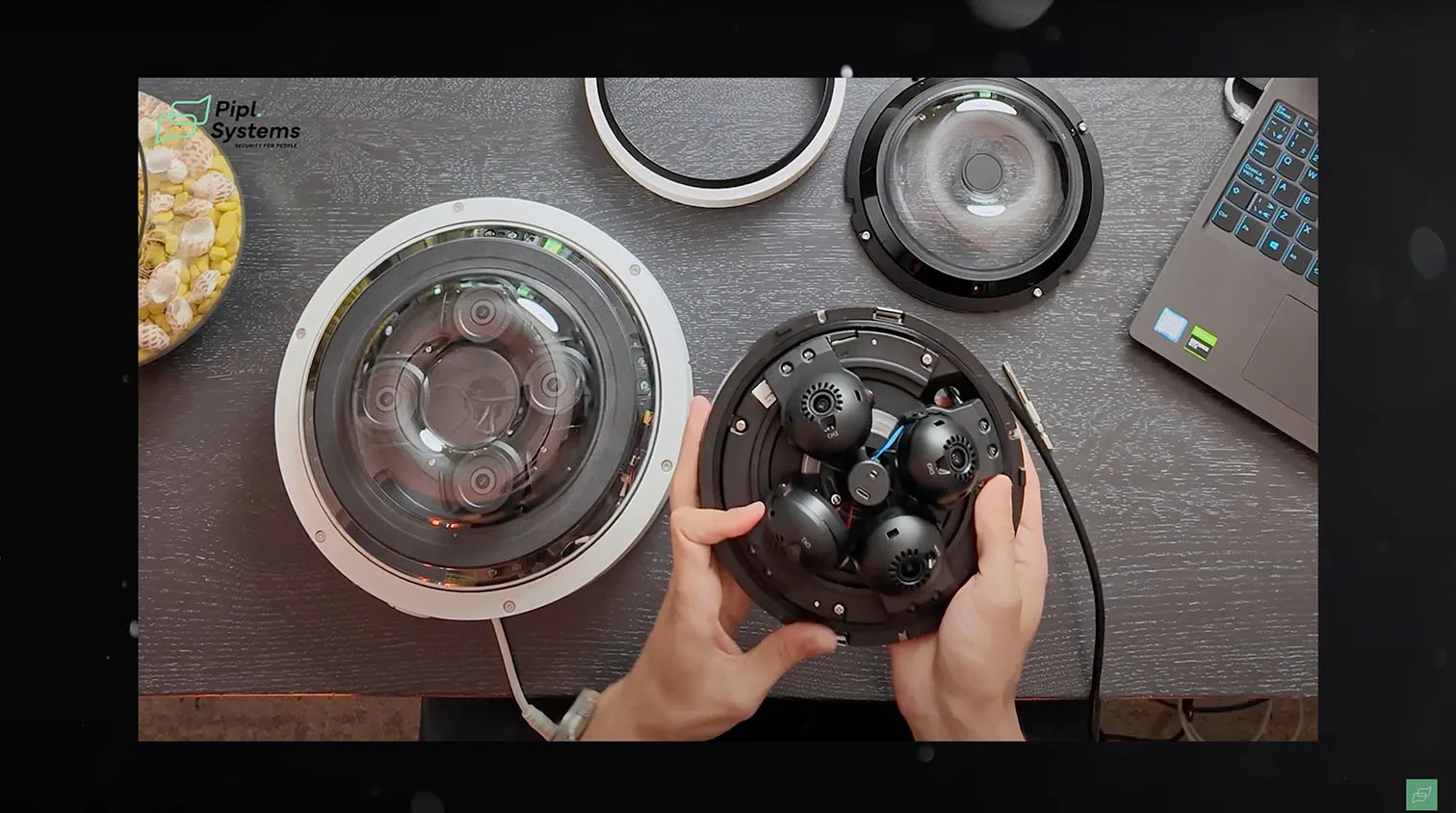
How Do Dual-Lens Cameras Work?
Stitching technology and distortion lines
The camera synchronizes two 8MP feeds, warps edges to align verticals, and blends exposure across the overlap. You may notice a faint stitch seam in the center when subjects pass slowly through the overlap region. That artifact is normal and brief. Proper mounting height and keeping the horizon level help minimize visible distortion.
Real-world performance at 16MP Ultra HD
A fused 16MP panoramic frame carries more pixels than a single 4K stream. Expect higher bitrates than a standard camera and plan NVR storage accordingly. Both Reolink Duo 3V PoE and ANNKE I91ET top out at 20 fps on the main panoramic stream, which is sufficient for entrances, sidewalks, and driveways. In testing, the added resolution preserved license plate shape and clothing color better than a single fixed 4K view covering the same width.
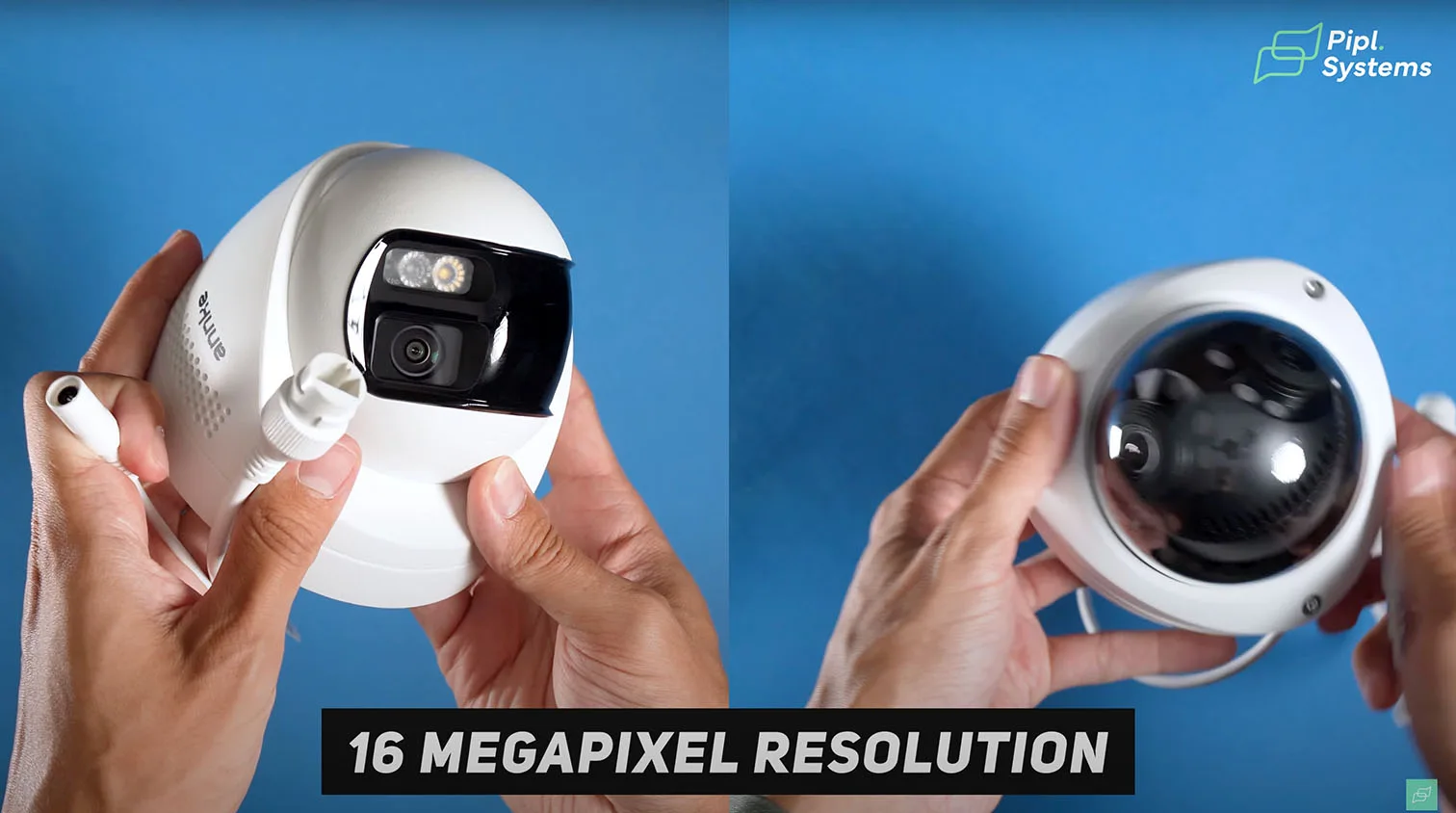
Deep learning AI features
Dual-lens models now include on-camera analytics to reduce noise and speed search. Reolink’s Duo 3V offers motion detection, person detection, vehicle detection, and animal detection, plus time-lapse and spotlight-driven color night vision. ANNKE’s I91ET adds human and vehicle classification with 120 dB WDR, Smart Dual Light that toggles IR and white LEDs, an audio siren, and strobe options for active deterrence. These AI tools cut false alerts and make it faster to scrub the timeline for relevant events.
For readers exploring affordable options without sacrificing performance, Reolink’s CX series deserves attention. The CX810 and CX820 deliver 4K clarity with built-in AI features like person and vehicle detection, making them a strong choice for homeowners or small business owners who want smart coverage on a budget. These cameras are particularly appealing for anyone upgrading from older 1080p systems, offering sharper detail and better analytics at an accessible price point. You can dive deeper into their strengths in our full review here: Reolink CX810 and CX820 Review: Budget AI Cameras with 4K Power.
Comparison Table: Reolink Duo 3V vs. ANNKE I91ET
| Feature | Reolink Duo 3V PoE | ANNKE I91ET (AN-I91ET0102) |
|---|---|---|
| Sensors and Resolution | Dual 8MP sensors fused to 16MP 7680×2160 | Dual 8MP sensors fused to 16MP 4096×1860 |
| Frame Rate (Main) | Up to 20 fps | Up to 20 fps |
| Lenses | 2.8 mm, F1.6 | 2.8 mm, F1.6 |
| Field of View | 180° horizontal, ~53° vertical | 180° horizontal, ~77° vertical |
| Video Compression | H.265 main, H.264 sub | H.265+/H.265/H.264+/H.264, MJPEG (sub) |
| Night Vision | IR 850 nm to ~30 m, spotlight color night 4500K | Smart Dual Light with IR and white LEDs to ~30 m, strobe and audio alarm options |
| WDR and Imaging Aids | IR-cut filter, time-lapse | 120 dB WDR, BLC/HLC/3D DNR, ROI |
| On-Camera AI | Motion detection, person detection, vehicle detection, animal detection | Human and vehicle detection, motion detection 2.0 |
| Audio | Two-way audio, built-in mic and speaker | Two-way audio, built-in mic and speaker, customizable audio alarm |
| Power | PoE 802.3af or 12 VDC | PoE 802.3af or 12 VDC |
| Network | 10/100 RJ45, ONVIF/RTSP supported | 10/100 RJ45, ONVIF supported, IPv4/IPv6, QoS |
| Local Storage | microSD up to 256 GB | microSD up to 512 GB |
| Weather and Hardening | IP67, IK10 vandal-resistant dome option | IP67 outdoor-rated |
| Operating Temp | −15°C to +45°C | −30°C to +60°C |
| Management and Apps | Reolink app, browser support for Edge/Chrome/Firefox/Safari, Windows/macOS clients | ANNKE app and web tools, wide protocol support |
| NVR Integration | Two-way audio, built-in mic, and speaker | Warranty policy varies by region and model; confirm on the purchase page |
| Warranty Note | ANNKE NVR with H.265+ efficiency, ONVIF VMS, and third-party NVRs | Storefronts, vestibules, and backlit entries where WDR and deterrent lighting help |
| Typical Use | Listed as a 2-year limited warranty | Reolink NVR, ONVIF VMS, and third-party NVRs |
Pricing changes with promotions and bundles, especially when paired with Reolink NVRs or ANNKE kits. Check current street pricing and regional warranty terms before you buy, and match features to your site: if you need tougher impact resistance and spotlight color night, Reolink’s Duo 3V PoE dome is compelling. If you want stronger backlight handling, larger microSD capacity, and active deterrence with audio and strobe, the ANNKE I91ET is a strong alternative.
For many homeowners, wireless convenience is the deciding factor when choosing a security system. Reolink’s WiFi lineup combines flexibility with strong performance, making it possible to cover entrances, garages, or even rental properties without running new cables. These cameras deliver smart features like person and vehicle detection, reliable app controls, and compatibility with both standalone setups and hybrid systems. To see which model best fits your needs, take a look at our full breakdown here: Reolink WiFi Cameras 2025: Which Model Fits Your Security Needs?.
Final Thoughts
Why Reolink Duo 3V and ANNKE I91ET stand out in 2025

Both models solve a very common problem elegantly: how to watch a wide area without installing two separate cameras. The Reolink Duo 3V PoE fuses dual 8MP sensors into a sharp 16MP panoramic image, adds an IK10 dome option for vandal resistance, and uses a warm 4500K spotlight for color night vision. ANNKE’s I91ET pairs its 16MP panorama with 120 dB WDR for tough backlight, Smart Dual Light that switches between IR and white LEDs, and active deterrence via strobe and audible alerts. Each is a capable PoE security camera that covers entrances, driveways, and storefronts with fewer blind spots and less wiring.
How dual-lens technology fits the modern security camera system
Dual-lens panoramic cameras offer a constant 180° context. There’s no “pan-away” risk like on PTZ, no need to dedicate two recorder channels, and fewer mounting points to waterproof. In a mixed system, they complement long-lens bullets (for IDs across distance) and small domes (for interiors). With on-camera motion detection, person detection, vehicle detection, and even animal detection, triaging events is faster, and the 16MP canvas retains useful detail across the frame.
Pipl Systems’ expert verdict on panoramic dual-lens solutions
If your priority is “see everything at once” across a wide frontage, this category is hard to beat. Choose Reolink’s Duo 3V when you want an IK10 dome, color night via spotlight, and straightforward app/NVR integration in the Reolink ecosystem. Opt for ANNKE’s I91ET when strong WDR, higher microSD capacity (up to 512 GB), and active deterrence are high on the list. For the best results, validate NVR throughput for a 16MP stream, size storage accordingly, and mount level to minimize the central stitch seam. In 2025, these panoramic tools deliver serious coverage with less complexity and excellent value for homeowners and SMBs alike.
Pick up your Reolink Duo 3V PoE or ANNKE 8MP UHD Dual-Lens Outdoor PoE Security Camera (AN-I91ET0102) via our affiliate link:
FAQ: Dual-Lens Panoramic Cameras
Are dual-lens cameras good for home security?
Yes. They provide a continuous 180° view that covers porches, garages, and driveways without gaps. You’ll see events unfold left-to-right in one frame, which is ideal for incident review. Expect a faint stitch line in the center if someone crosses the overlap slowly, but it doesn’t affect practical visibility when mounted correctly.
What’s the difference between dual-lens and PTZ cameras?
Dual-lens cameras are fixed and always show the full 180° scene; PTZ cameras move and only record where they’re pointed. PTZ shines on large lots for tracked pursuits or optical zoom identification. Dual-lens wins for entrances and storefronts where uninterrupted coverage is more valuable than chasing a subject. Dual-lens also uses standard PoE and has no moving parts to service, while some PTZ models require PoE+ or PoE++.
Do Reolink and ANNKE dual-lens cameras work with NVR systems?
Yes. Reolink Duo 3V PoE works with Reolink NVRs and most ONVIF recorders/VMS. ANNKE I91ET works with ANNKE NVRs and ONVIF platforms. Each camera typically consumes one recorder channel for its fused panoramic stream. Confirm your NVR’s total incoming bandwidth can handle a 16MP H.265 stream at up to 20 fps.
Can you use microSD cards with these cameras?
Yes. ANNKE I91ET supports microSD up to 512 GB; Reolink Duo 3V supports up to 256 GB. Edge storage is great for short-term buffering or redundancy, but for retention beyond a few days at 16MP, pair the camera with an NVR or NAS.
How does motion detection and AI classification work?
Both cameras analyze the panoramic frame on-device to reduce false alerts. Reolink provides motion detection, person detection, vehicle detection, and animal detection. ANNKE focuses on human and vehicle classification with Motion Detection 2.0, plus 120 dB WDR to protect detail in backlit scenes. Set zones and sensitivity to match your site, and use schedules to quiet overnight nuisance alerts.
Which camera is better for businesses vs. residential setups?
For residences, Reolink’s IK10 dome option and spotlight color night vision make it a strong front-door pick. For small businesses with glass entries or bright signage, ANNKE’s 120 dB WDR and Smart Dual Light help balance backlight and add strobe/audio deterrence. Both are IP67 weather-rated and suitable outdoors; your choice should hinge on environment (backlight vs. vandal risk), storage needs (256 GB vs. 512 GB), and the NVR ecosystem you plan to use.

